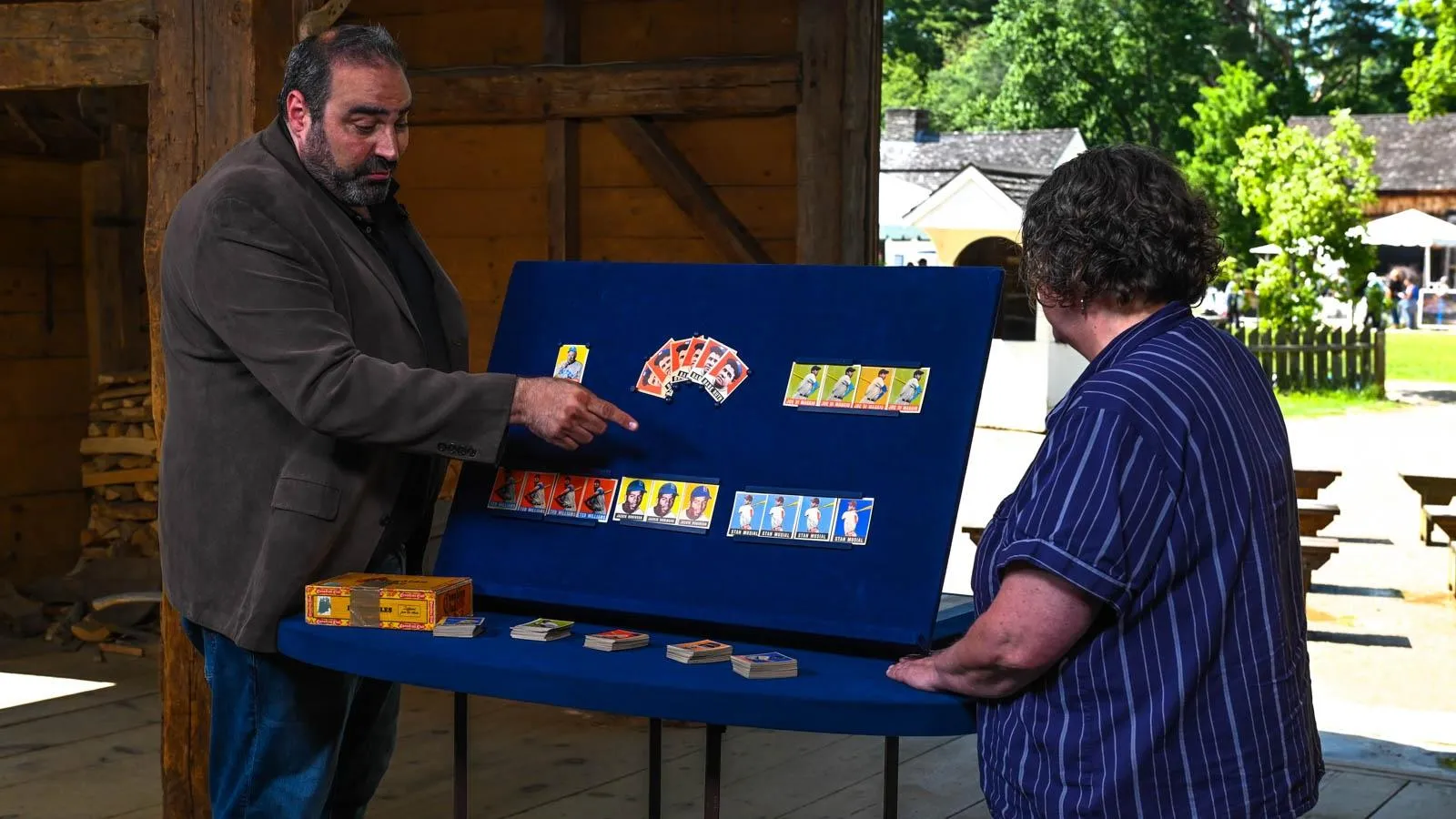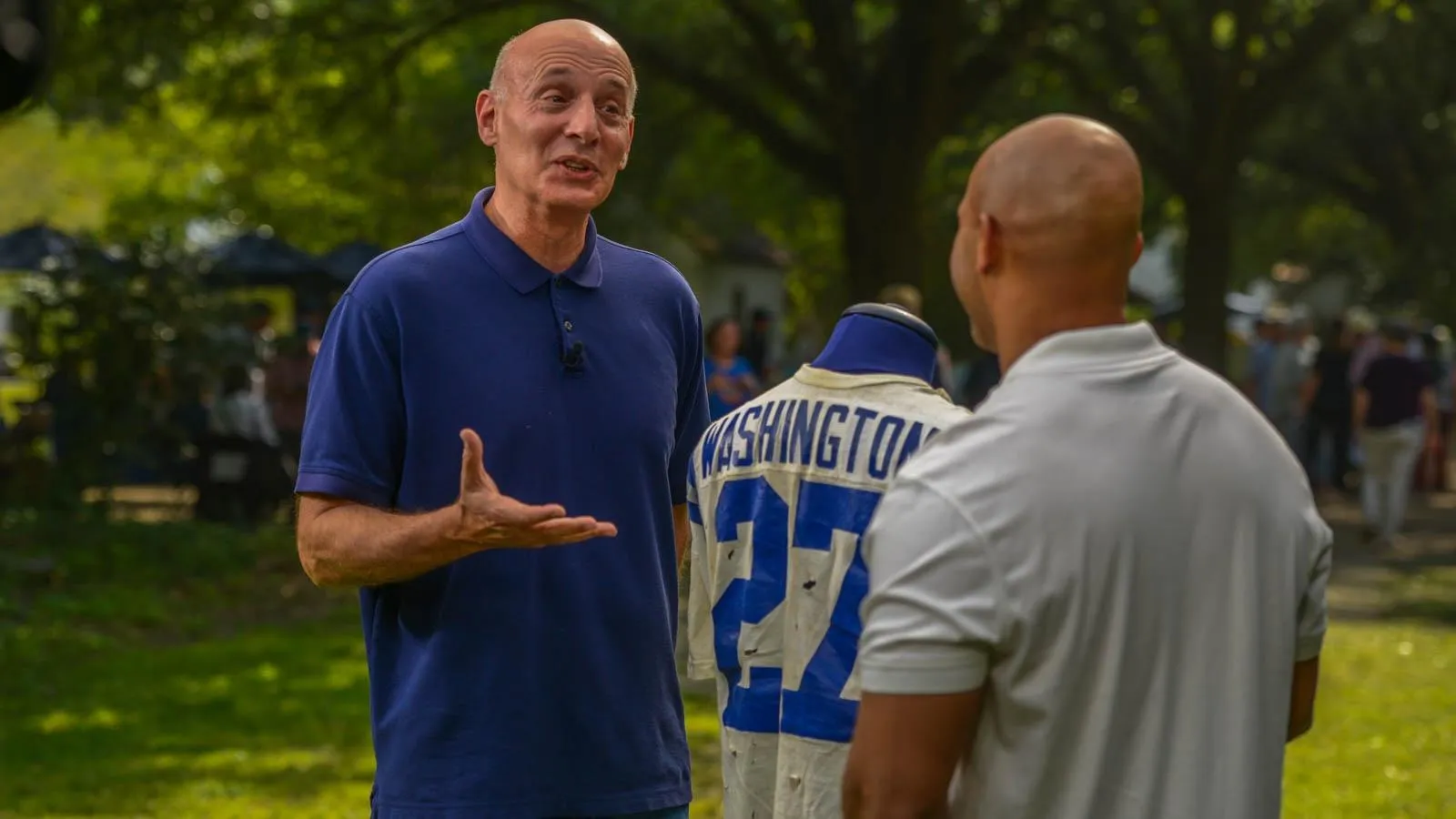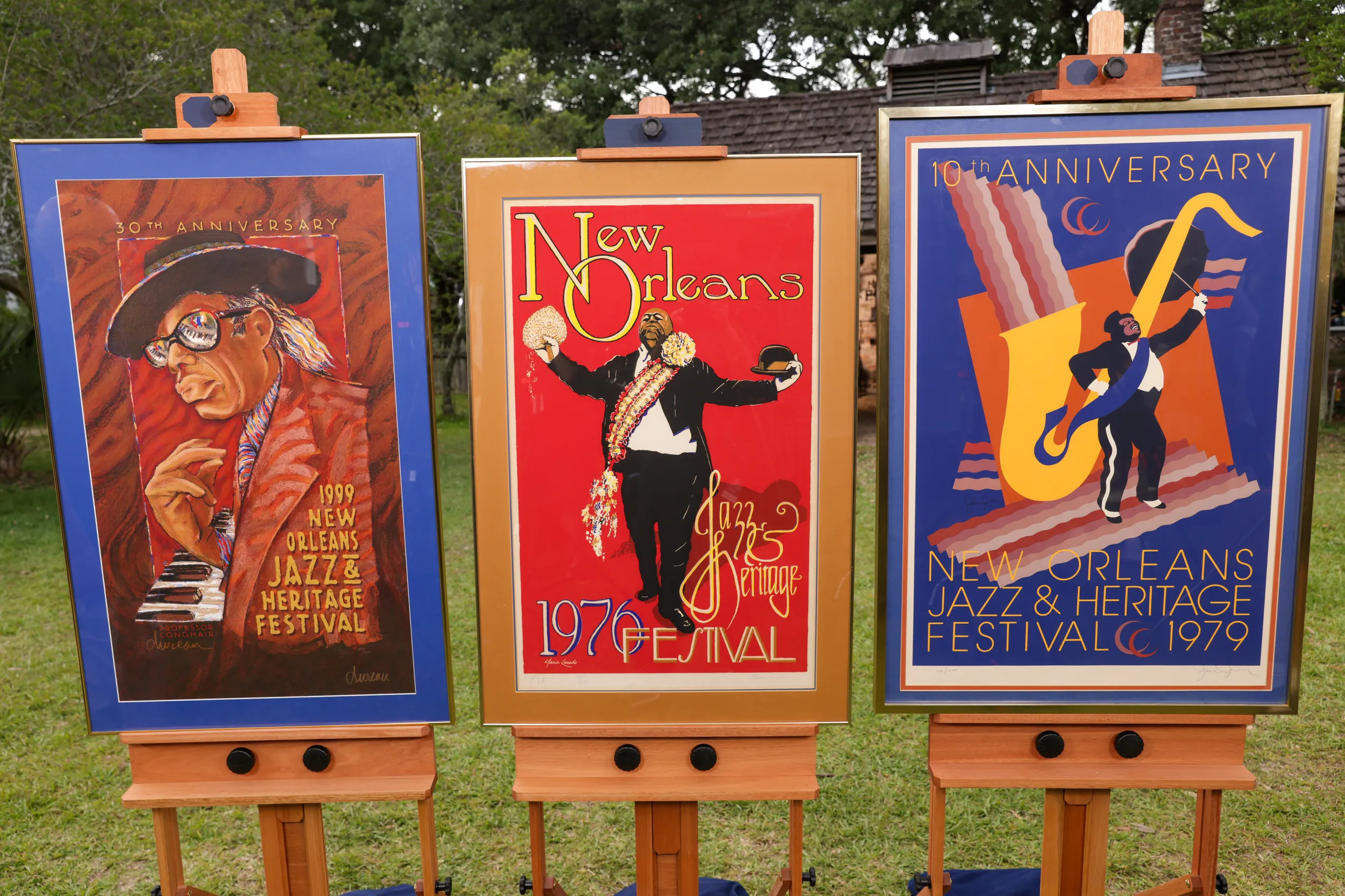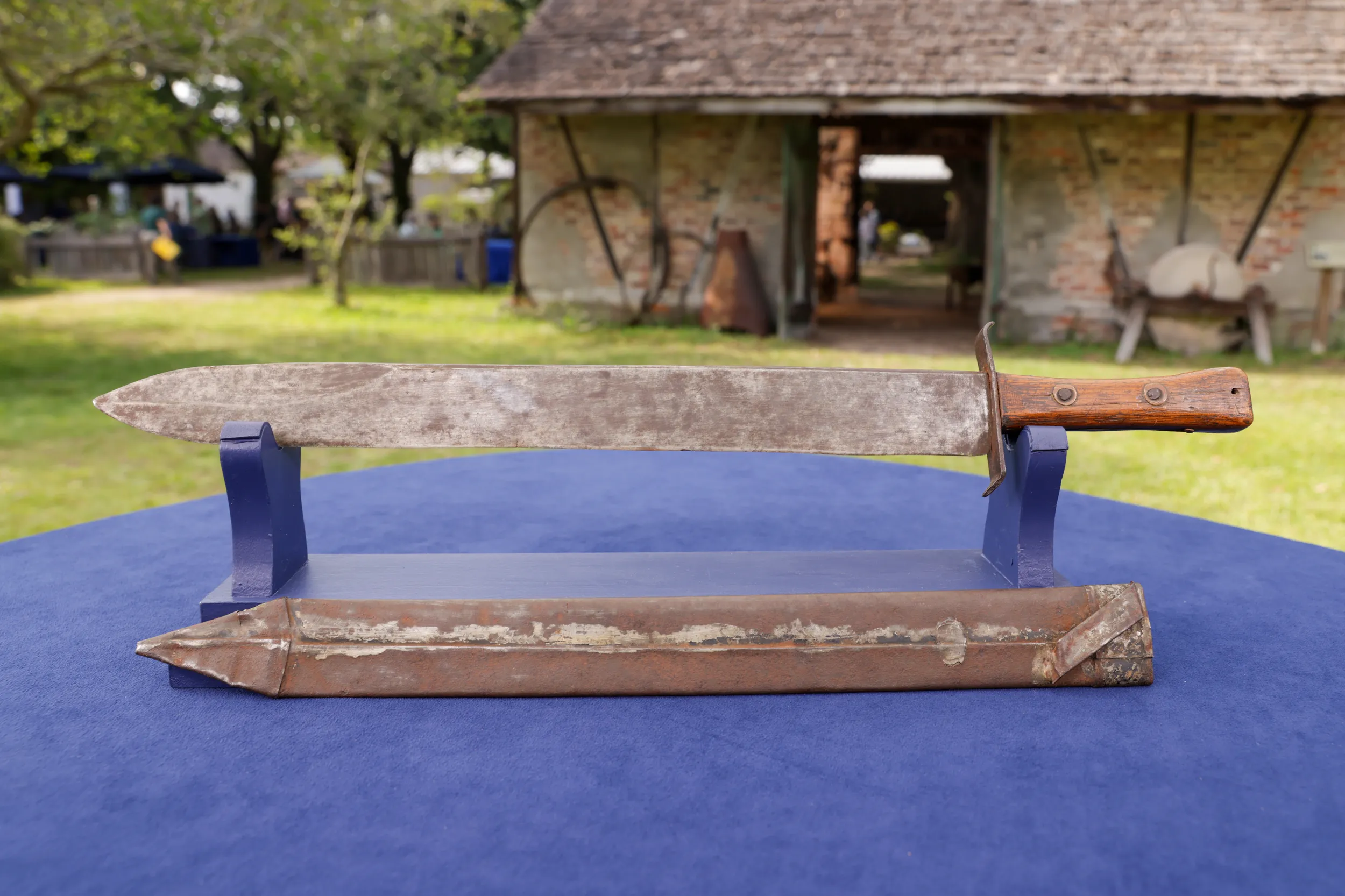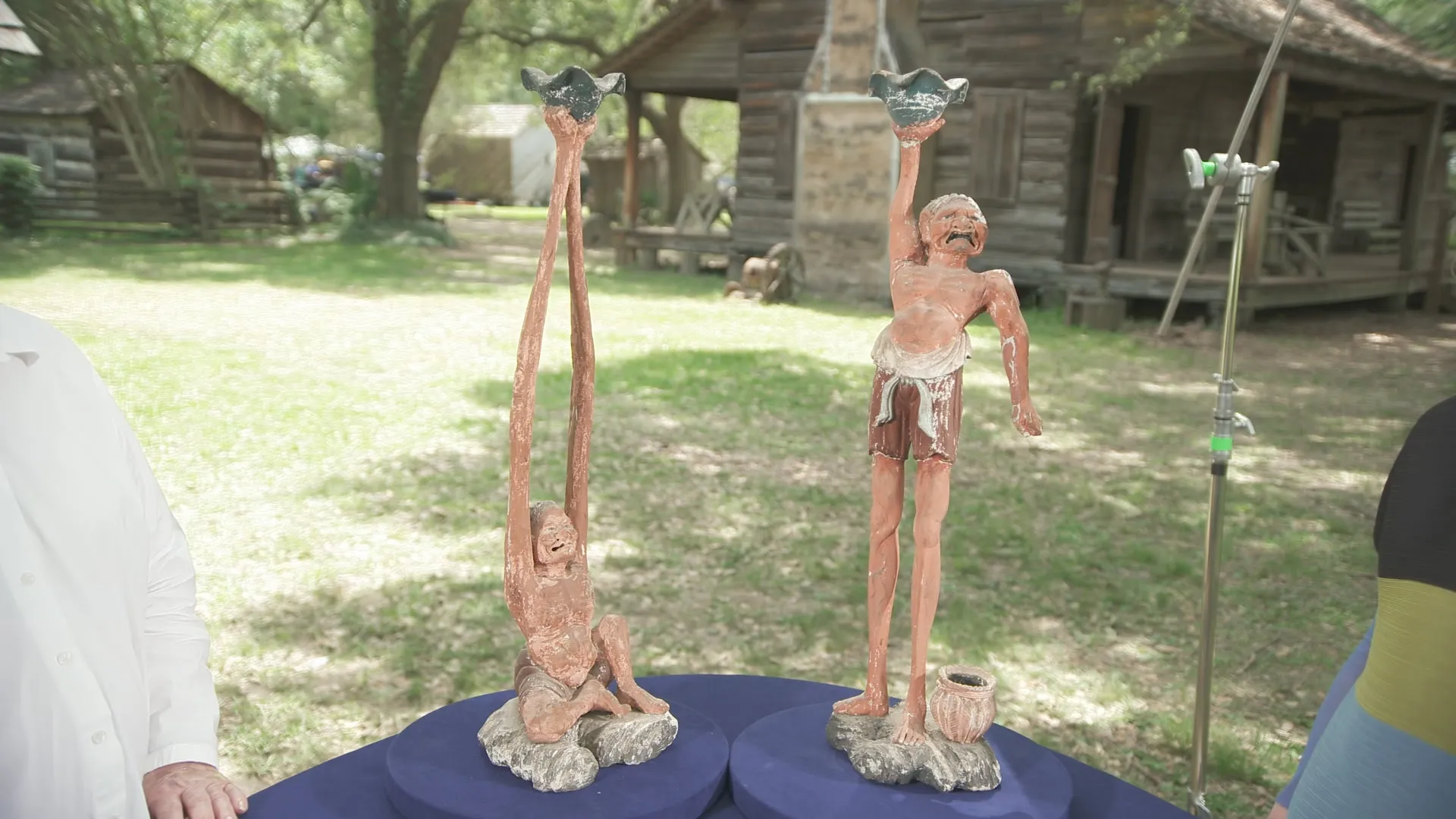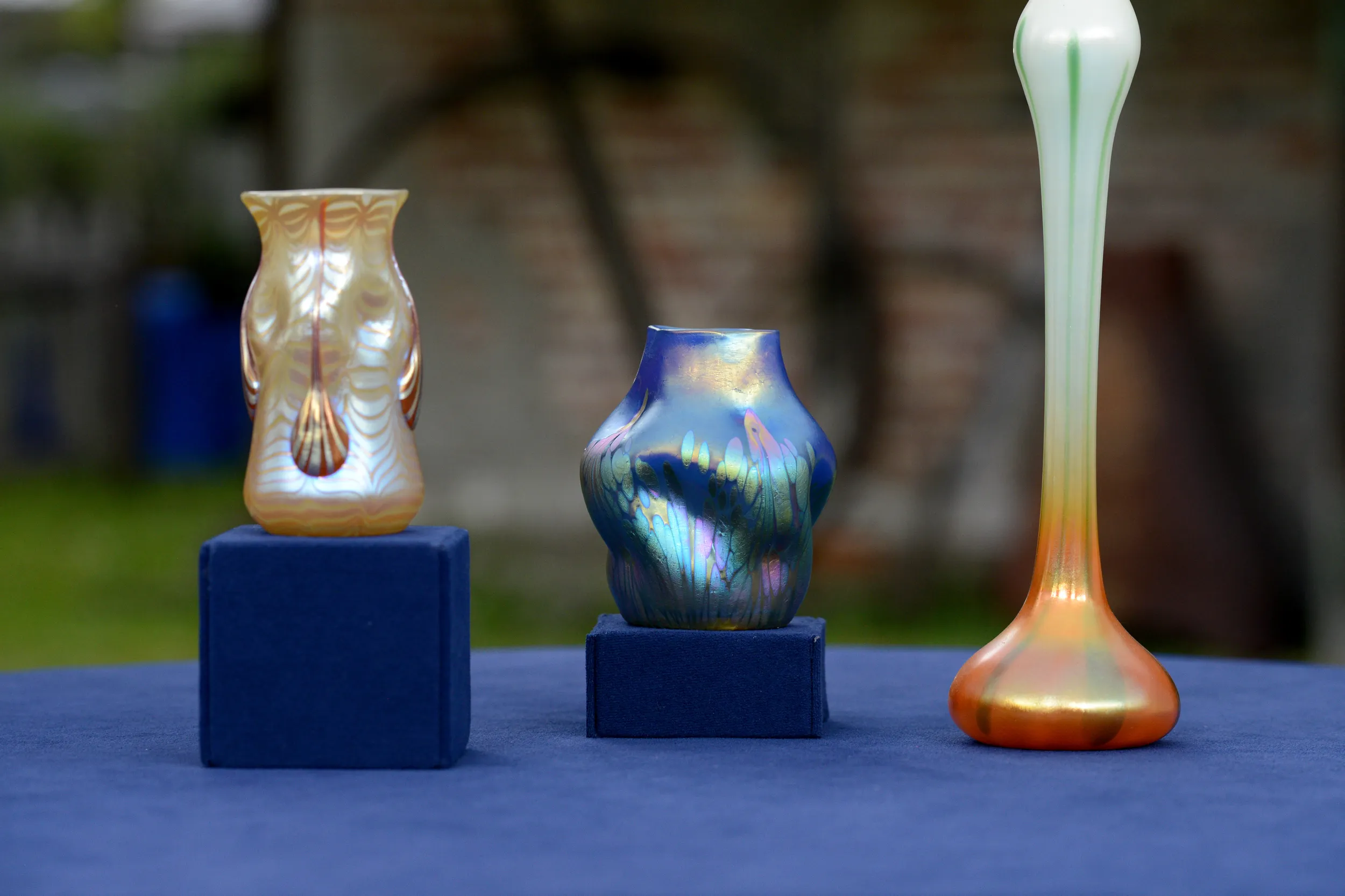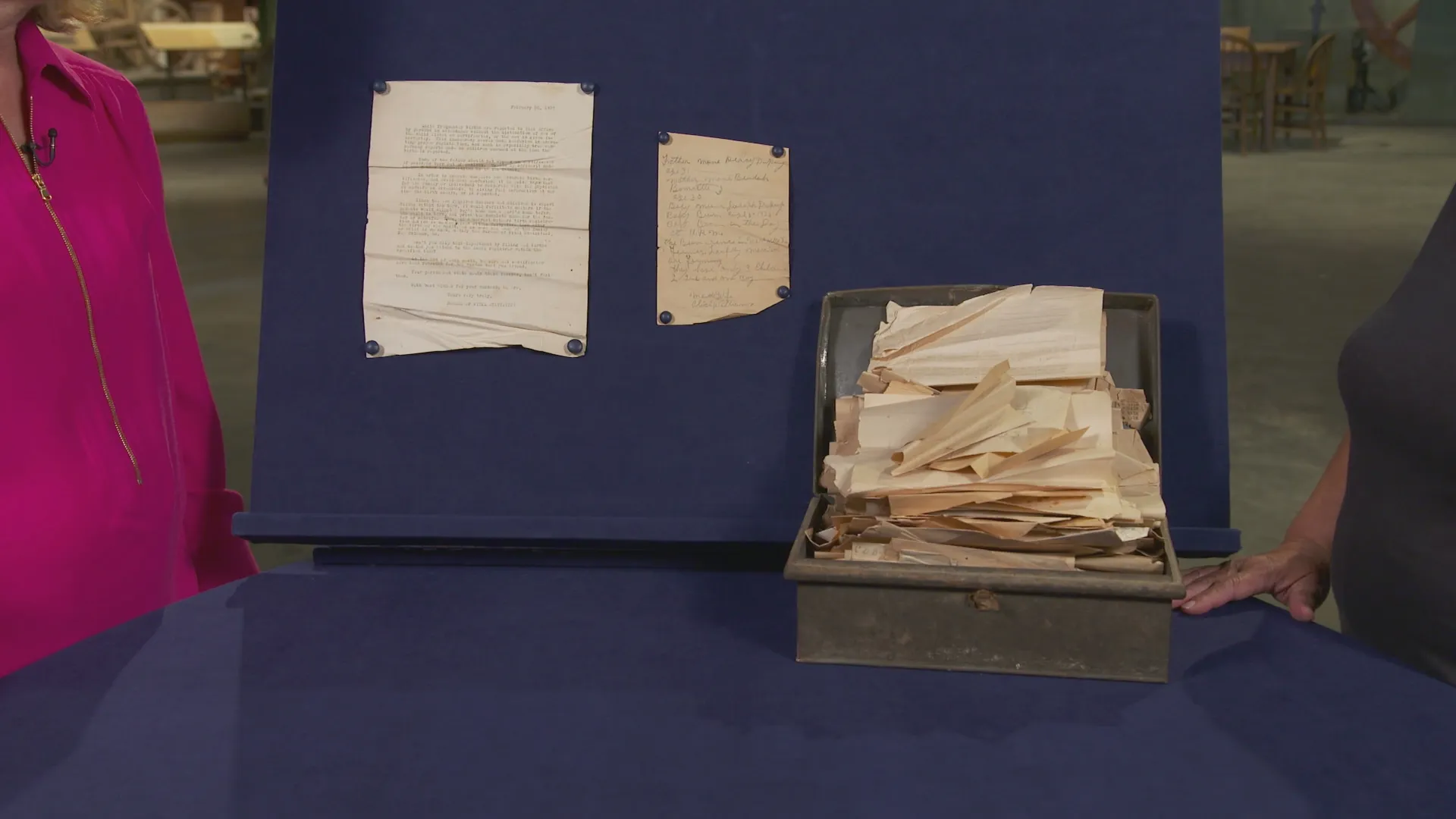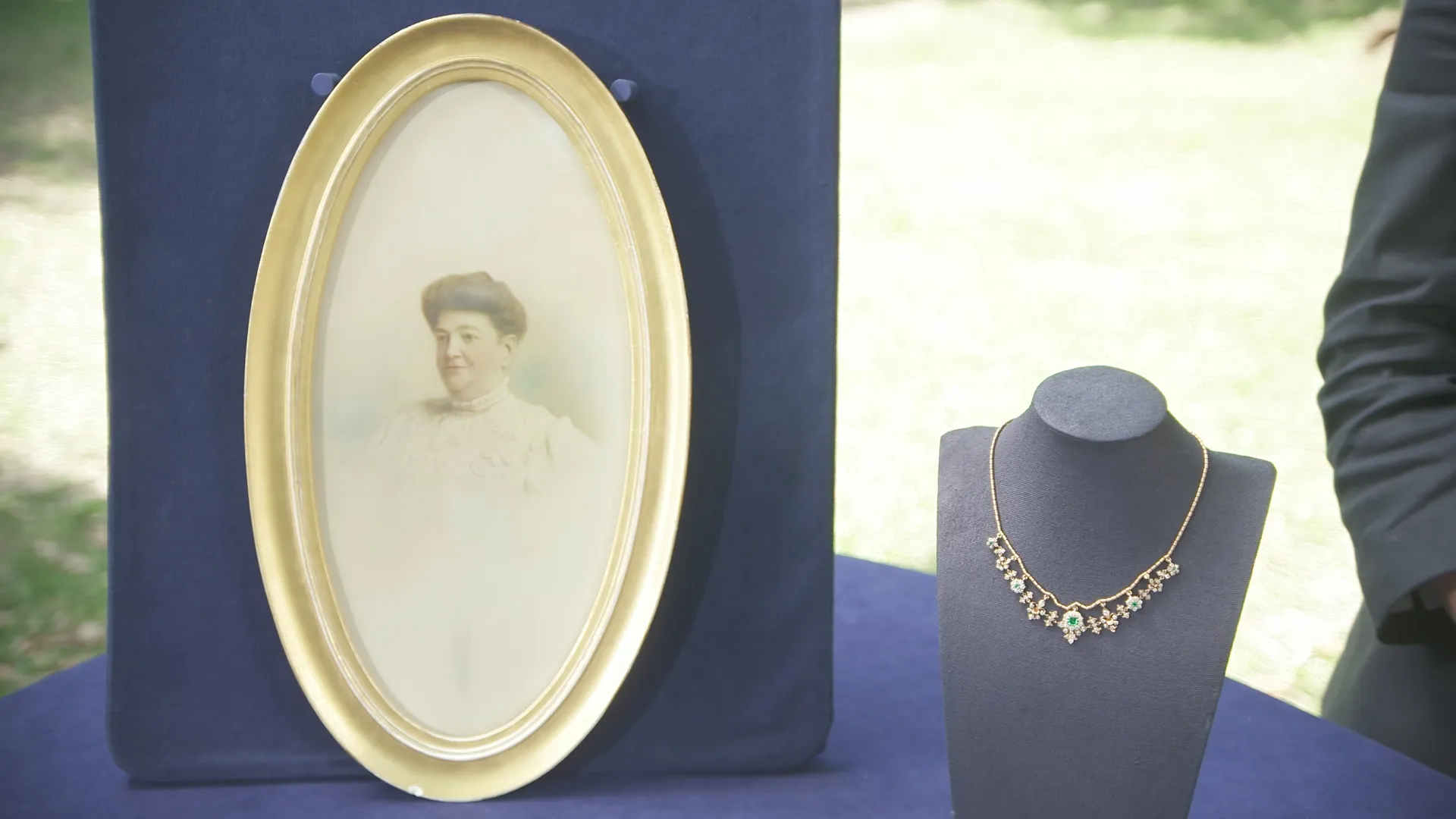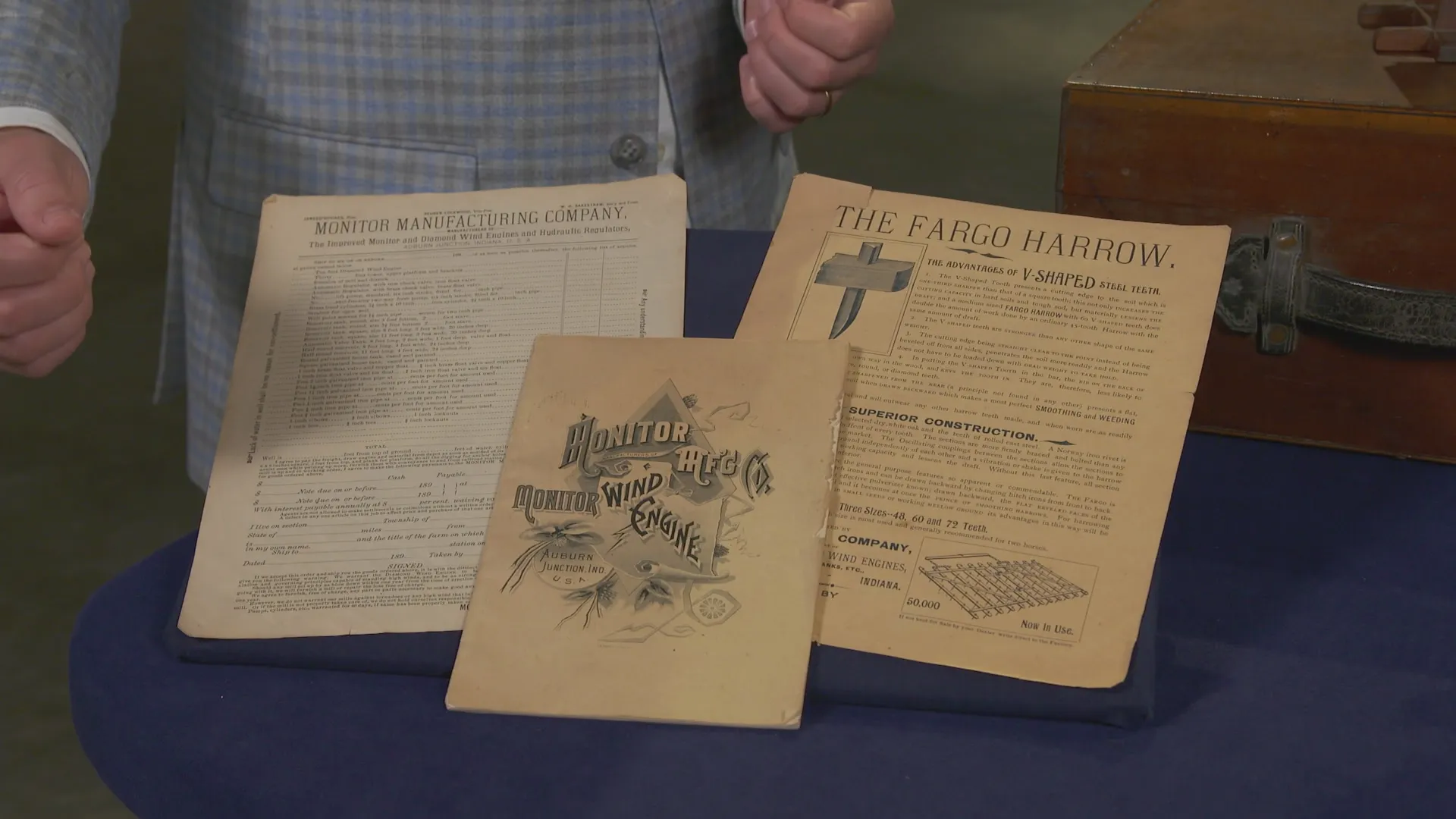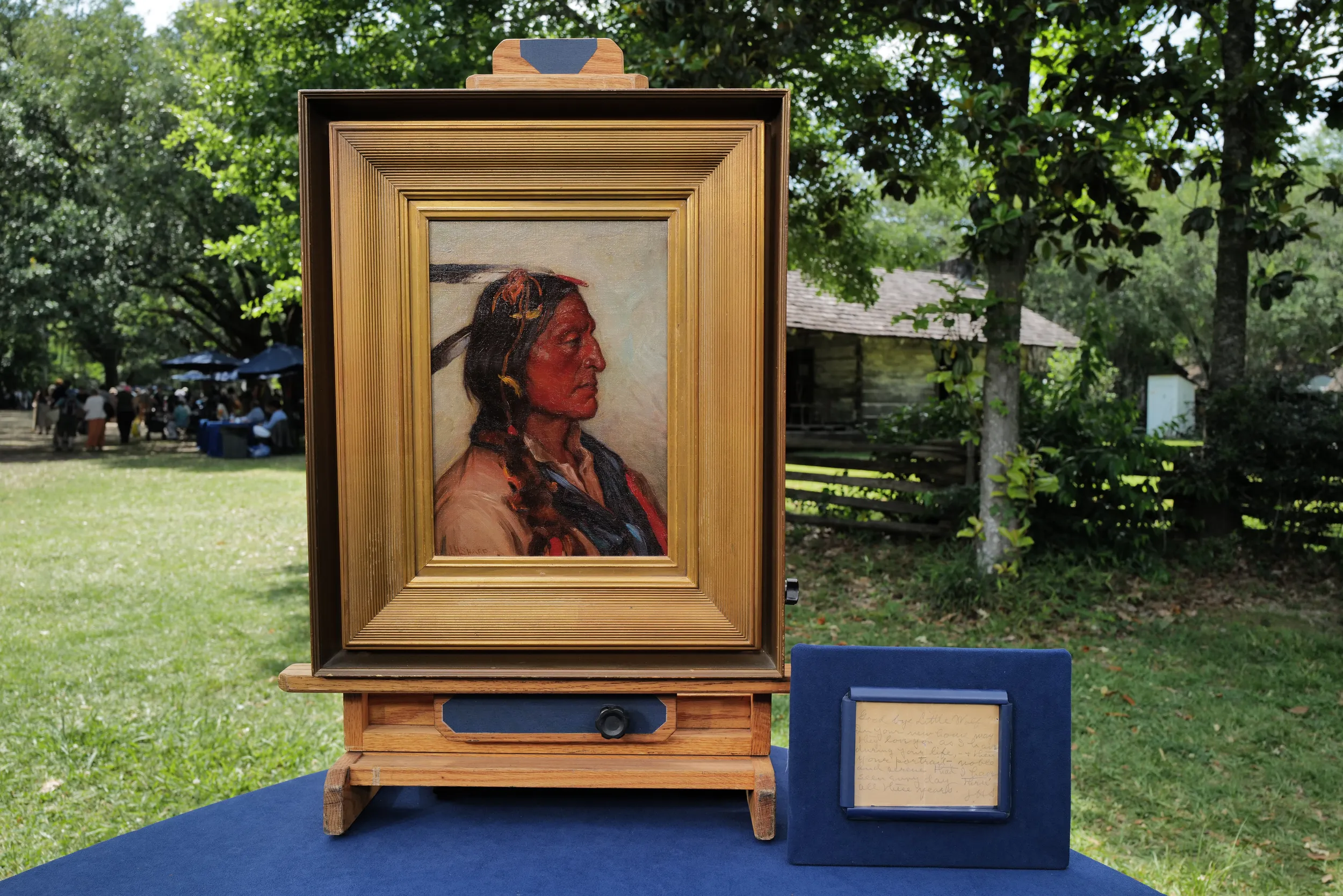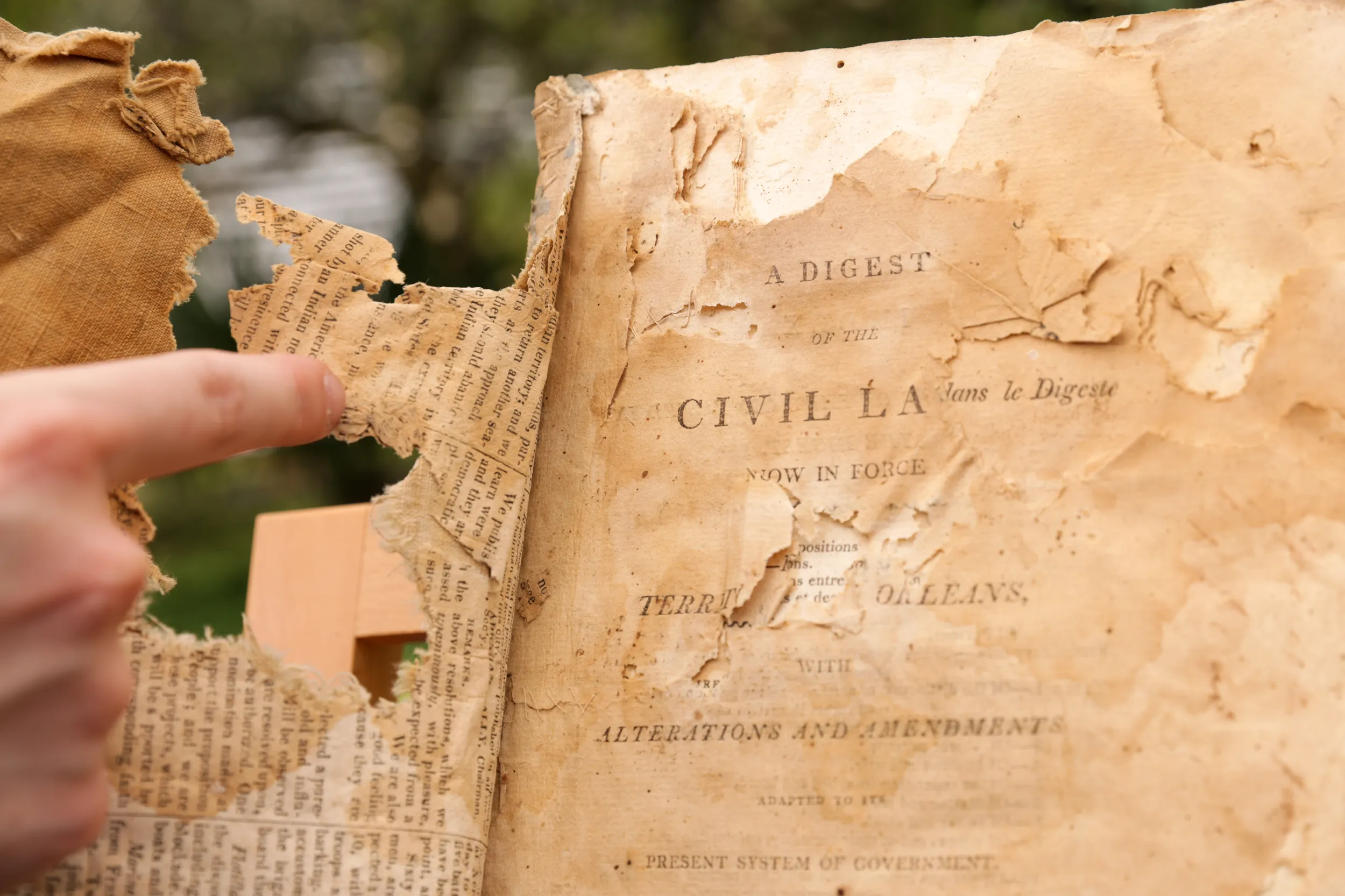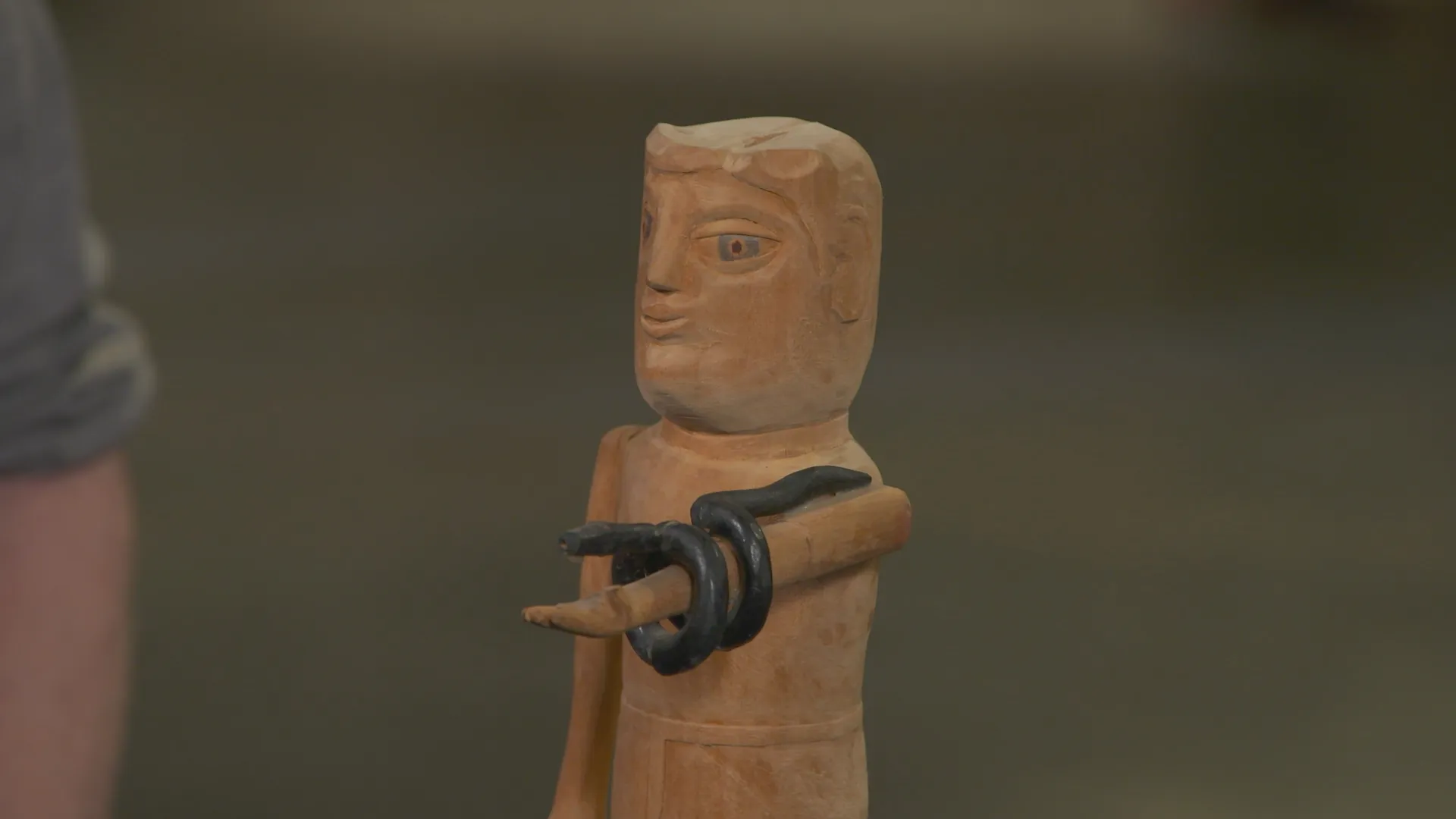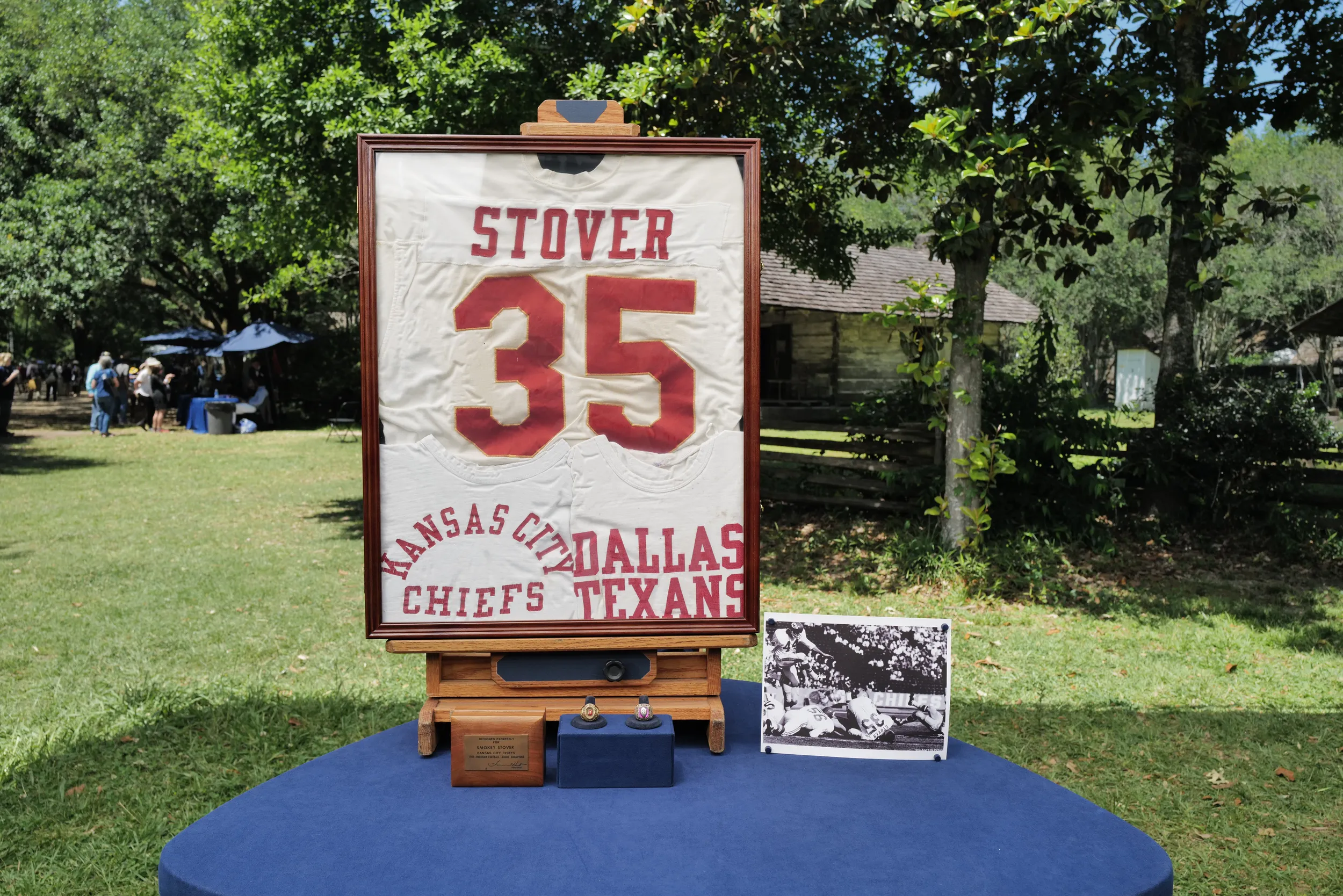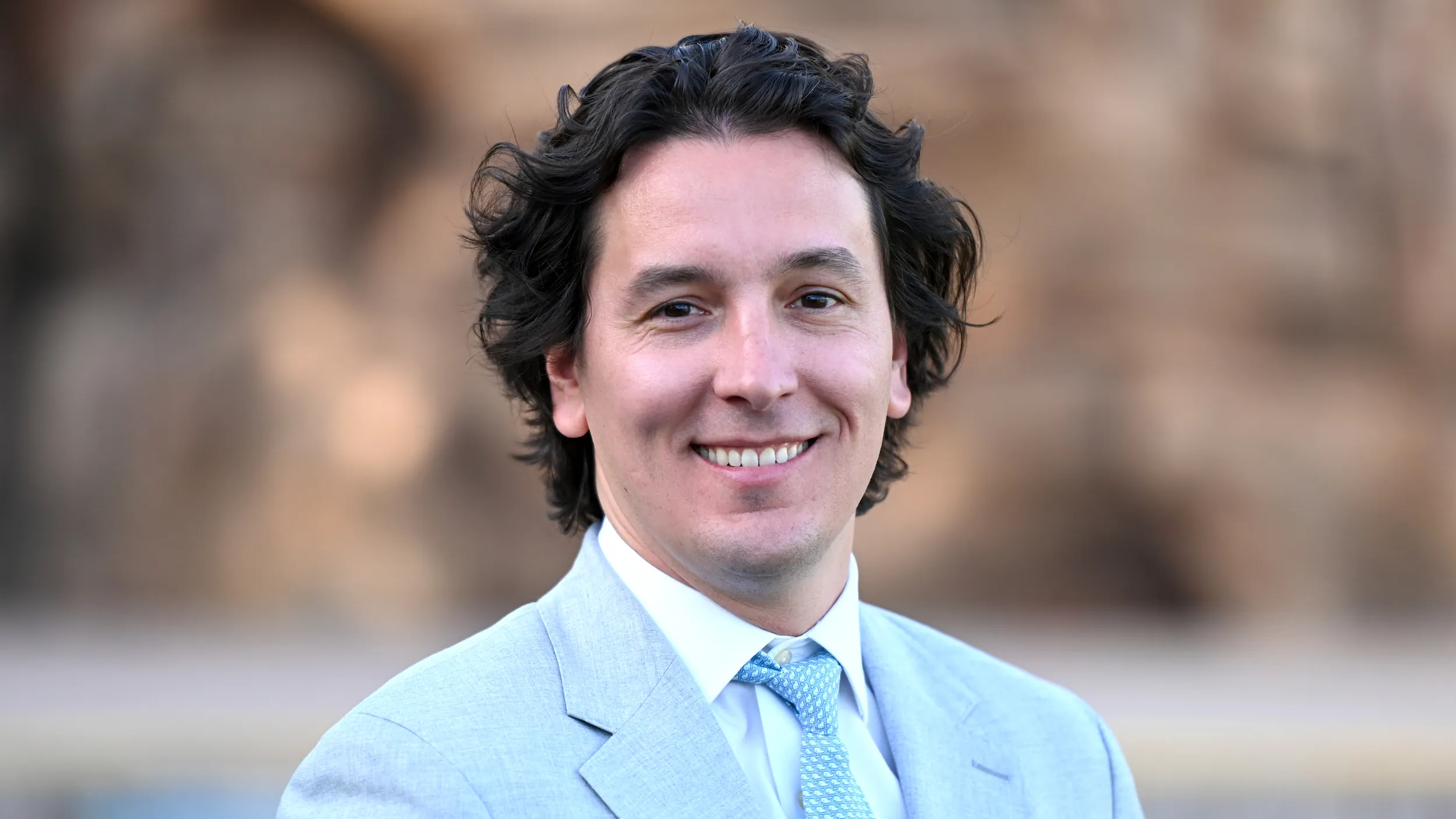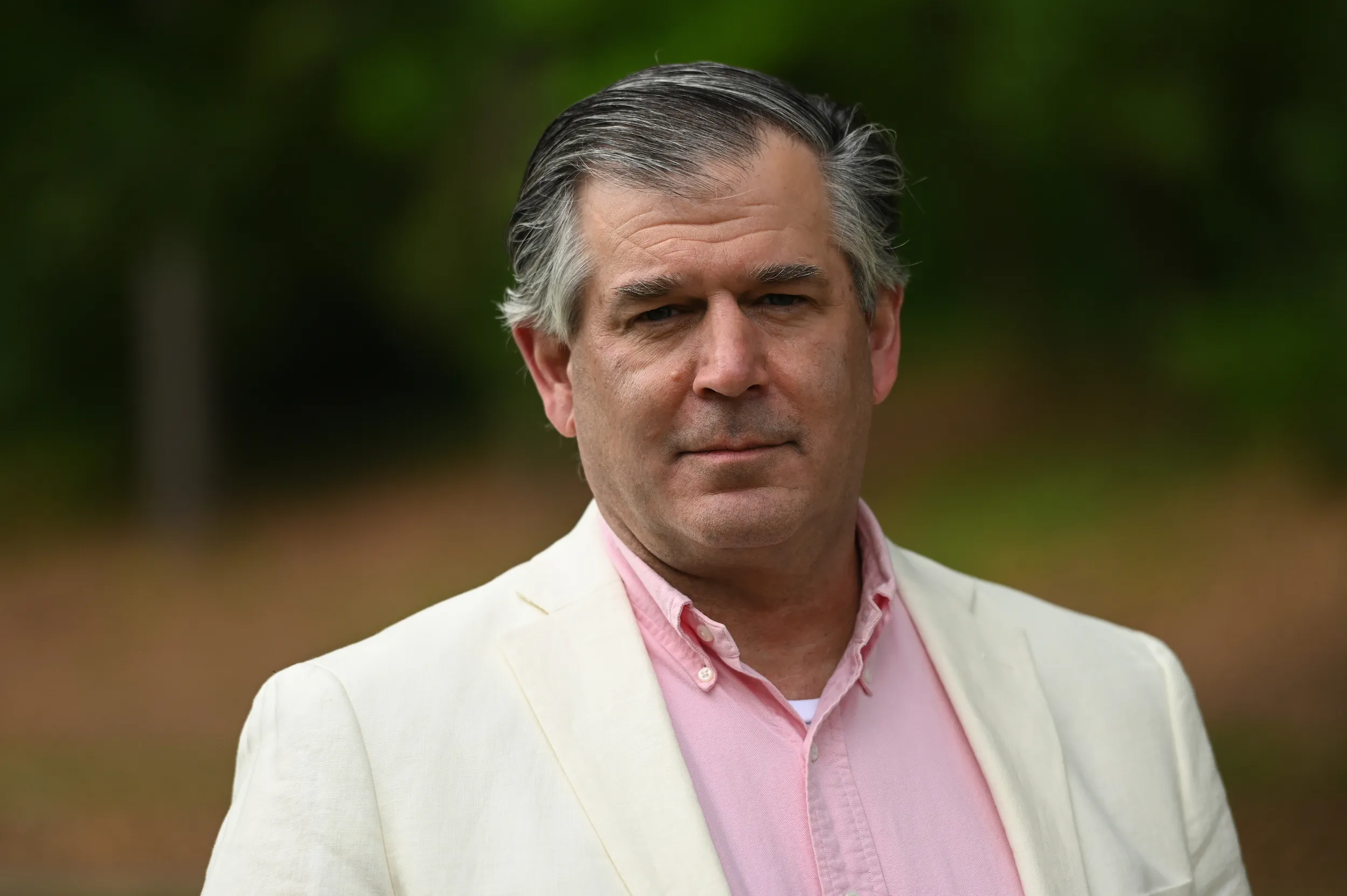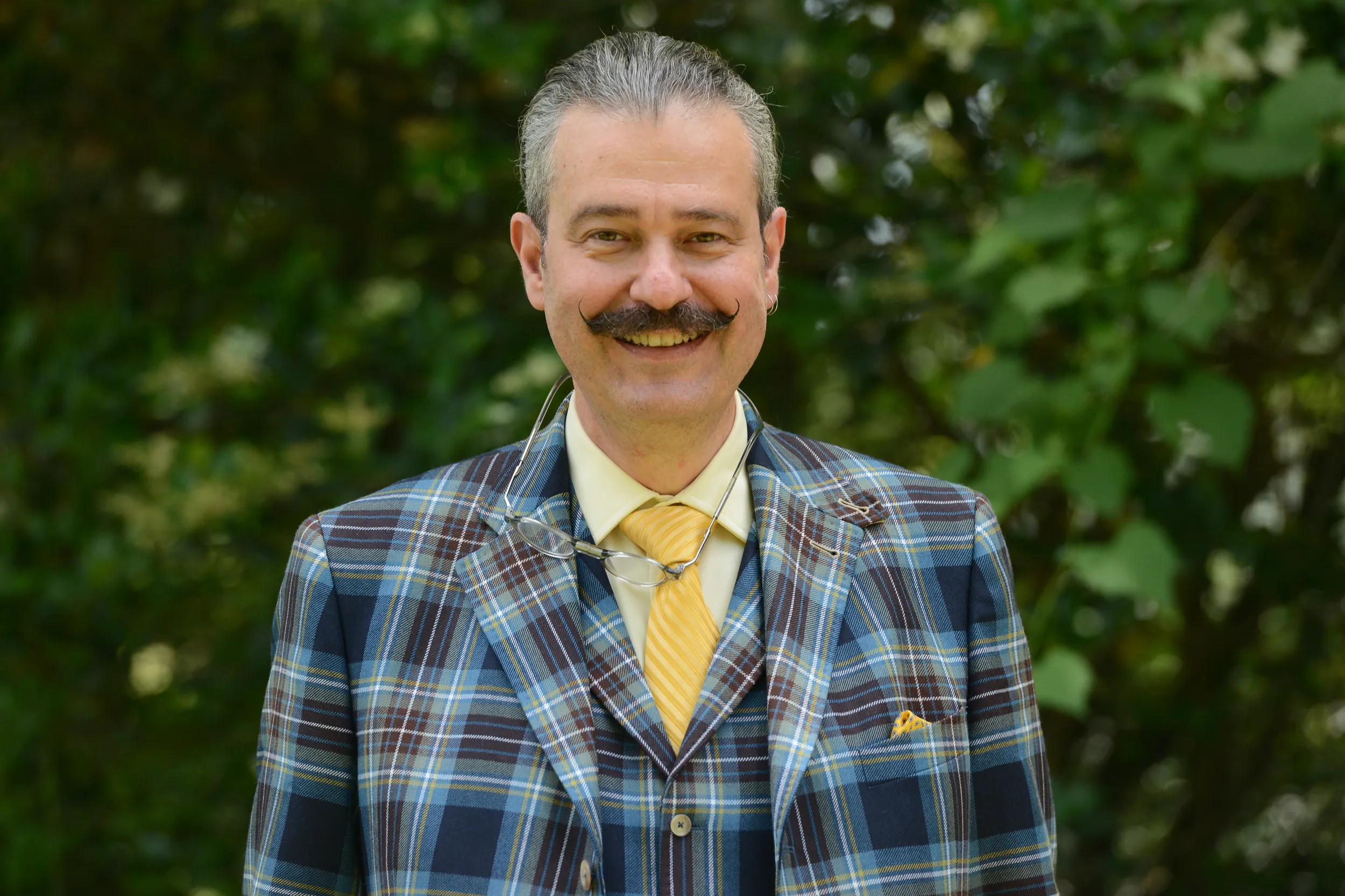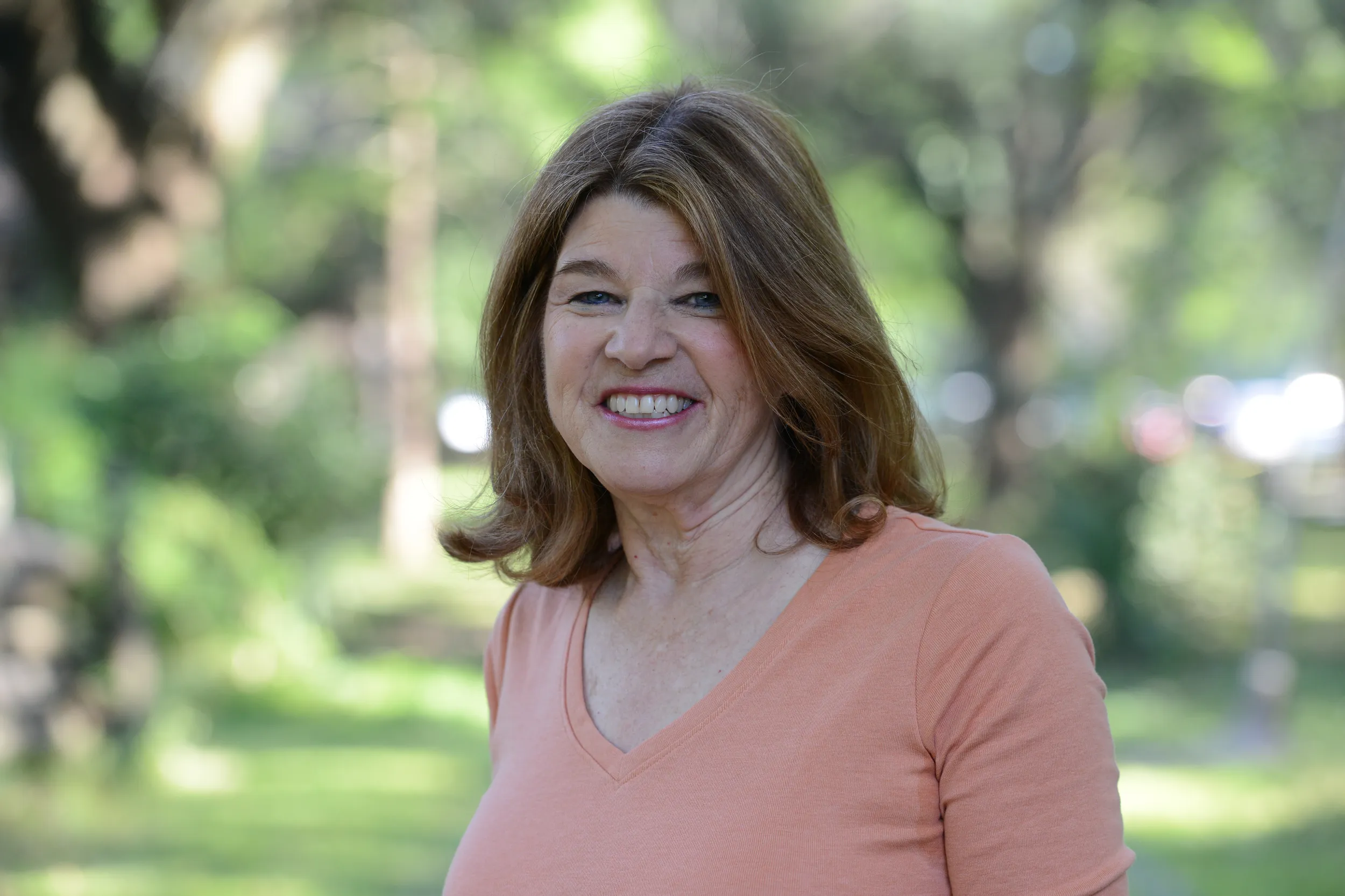HOST: ANTIQUES ROADSHOW is ready to sow the seeds of knowledge at the Rural Life Museum in Baton Rouge.
GUEST: I have been going to the Jazz Fest for 50 years.
GUEST: And I've never seen anything like it, so just curious what it's about.
HOST: ROADSHOW has set up at the Rural Life Museum, which encompasses gardens, historical buildings, and a collection dedicated to 19th- and 20th-century folk crafts, commercial wares, and farming equipment. Part of the Louisiana State University campus, the museum is on land that was once the Windrush Plantation, the legacy of the Burden family. Ione, Pike, and Steele Burden were siblings who began donating portions of their estate to LSU in the mid-1960s. The Burdens wanted to preserve the land that meant so much to their forebears and to educate people about what was life for the laboring classes of Louisiana's past: enslaved Black plantation workers, Black and white sharecroppers, tenant farmers, and yeoman farmers. ROADSHOW is set up and ready to educate our guests about the history and value of their treasures.
GUESTS: Hello! Hi! Hi! (laughing)
GUEST: Well, I'm a Jazz Fest fan. I have been going to the Jazz Fest for 50 years, and I began collecting Jazz Fest posters in 1976. I paid ten dollars for that poster in 1976. I have a room in my house lined with Jazz Fest posters, and it brings me happiness every day.
APPRAISER: Jazz Fest is this extraordinary event. I mean, to call it a festival is an understatement. 12 different stages, music from all over the world, great food, arts and crafts, everything going on. And the festival began in 1970. And what you have are three of the official posters...
GUEST: Yes.
APPRAISER: ...from Jazz Fest. You have 1976, you have 1979, and you have 1999. So, Fred, how much did you pay for the two posters on either side?
GUEST: If memory serves me correctly, I believe I paid $50 for the 1979 poster. And I believe I paid $100 for the 1999 one. I'm a Professor Longhair fan. I don't care what it costs. I was gonna get that poster.
APPRAISER: These were issued as commemorative items.
GUEST: Yes.
APPRAISER: You love Jazz Fest. You brought them home. You weren't the only one. But in the early years, and we'll start with the earliest one we have here, in the center, 1,000 of them were printed, signed, and numbered, and 1,000 were printed unsigned, and they were sold at different prices. You have one that is signed by the artist, Maria Laredo...
GUEST: Mm-hmm.
APPRAISER: ...and numbered 483. But then, as the festival became more popular, these posters were printed in much larger numbers. 1979, 1,000 signed and numbered copies were printed. And you have this copy signed by the artist, John Martinez, numbered 494. But for the first time, the unsigned edition ran to 10,000.
GUEST: That I did not know.
APPRAISER: So they made 10,000 of them. And then, closest to you, we have the 1999 version, featuring the unparalleled Professor Longhair, Henry Roeland Byrd, one of, one of the great zydeco pianists out there. Just a, a remarkable performer. And the art is by a New Orleans favorite artist, George Valentine Dureau.
GUEST: Yes.
APPRAISER: And he has signed it, and he has numbered it. The numbers here are even bigger: 3,000.
GUEST: 3,000.
APPRAISER: So, the earliest one we have here in the center. It's a marshal of the parades, whose name was Fats Houston. He actually was so famous, he featured in two movies, uh, The Cincinnati Kid and the James Bond movie Live and Let Die.
GUEST: I've s, I've seen both those movies.
APPRAISER: Then you've seen him perform, and he's been on the wall of your special Jazz Fest room the whole time.
GUEST: I'll be. (chuckles)
APPRAISER: Any thoughts as to the value of these pieces?
GUEST: Well, my one in the middle, I'm hoping $1,000 for that.
APPRAISER: We'll start closest to you. We have the George Dureau Professor Longhair, of which 3,000 were printed, signed. So, when these come up for auction, they tend to sell for between $400 and $600.
GUEST: I believe I paid $100 for it, so I'm...
APPRAISER: So then we come to the John Martinez poster, which was the first year that the, the fair, festival organizers realized they may have had a, a, a new money-making strategy, which was by printing more posters. While not depicting any recognizable celebrity, really captures the joy of some of the performers and some of the entertainers and the marchers who were involved in the, the entire music scene in New Orleans. This poster, when it comes up to auction, signed and numbered like this, I think, conservatively, you could expect it to sell for $700 to $1,000. But then we come to the one in the middle. When you look for this poster, you see some vast differential in prices. If this were to appear in an auction, I would estimate it between $4,000 and $6,000. And when you look online...
GUEST: (exhales, chuckling)
APPRAISER: ...the high-water mark for this is $7,000, at an auction in New Orleans. And New Orleans is the place to sell something like this.
GUEST: Ten dollars! (laughs) This will go to my daughter and probably to her daughter, as well. This is family.
GUEST: The chair was purchased, I believe, somewhere in New Orleans. It was my mother-in-law's back in the '50s. I got 'em, and I'm always wonderin’ about 'em.
CREW: Are they comfortable to sit on?
GUEST: No. (all laughing)
GUEST: This was a part of my great-grandma's collection. She loved elephants, and she had gotten this, we believe, from China, we're not sure.
CREW: Any idea how old it is or anything?
GUEST: I'd say older than me. (laughs)
GUEST: This sword has been a part of my family as long as I can remember. Um, the stories that I was told, it was from my great-great-grandfather Jerome, who was a part of the Civil War, and he was in the 96th. He was born in New Orleans and then migrated to Mobile, in Alabama, and became a part of the, the Army there. I think I've got it, maybe, the last ten years. And it's been sentimental to us because it w, it was part of Grandpa Jerome.
APPRAISER: What was his last name?
GUEST: Nicholas.
APPRAISER: Jerome Nicholas -- do you know any more about his history?
GUEST: So, the only thing that I know was, I saw a census from, I think, the 18, 1870 census, and it showed that he was 30 years old. So that's about the furthest back that I have, the information that I know of.
APPRAISER: Jerome Nicholas was a member of the USCT, United States Colored Troops. The 96th USCT was a Union unit, and they were an engineer unit. He enlisted in 1864...
GUEST: Okay.
APPRAISER: ...September, as a private.
GUEST: Okay.
APPRAISER: By November, he was promoted to corporal.
GUEST: Wow.
APPRAISER: And soon after that, he was promoted to first sergeant. So he moved up through the ranks pretty quickly.
GUEST: Okay.
APPRAISER: The 96th USCT that your ancestor was in was formed a, from a, a lot of enslaved men who, then, once they were freed, once the Army had come through, joined the Union Army.
GUEST: Okay.
APPRAISER: Um, they were commanded by white officers.
GUEST: Okay.
APPRAISER: Um, but your relative rose up from private to corporal to first sergeant pretty quickly. So, he had the skills to be an officer. Do you know what he did before the war?
GUEST: He was a barber by profession.
APPRAISER: Really.
GUEST: Yes.
APPRAISER: So he was a free man.
GUEST: He was a free man.
APPRAISER: He mustered out of service in New Orleans. In 1866, he was discharged from the service. And what you have here is what most collectors would call a Confederate bowie knife.
GUEST: Okay.
APPRAISER: Now, it has some standard features, some a little bit different than others. You got this false edge in the blade right here. And you have this half tang, which is kind of uncommon. It's a one-piece grip, as opposed to a two-piece grip. Um, you got this simple little counterguard, um, these great rivets, and the blade is fairly heavy, but at the same time, it's really nicely balanced, but it's fairly crude. And you also have this tinned iron scabbard, which is phenomenal that that still survives. It's got a little bit of black paint, or japanning, still left on it. The belt loop is on it. W, what makes this a Confederate, uh, bowie knife? And that's basically what collectors call them. It's a Southern thing...
GUEST: Yes.
APPRAISER: ...the way that they're made, fairly crudely, but they're big and bulky and look really mean.
GUEST: Okay.
APPRAISER: Now, how did he get it? There's a, quite a possibility that he picked it up while he was in service. Then he carried it and used it...
GUEST: Okay.
APPRAISER: ...and probably brought it home as a trophy.
GUEST: Yes.
APPRAISER: It's one of those things that, for us, kind of makes the hair stand up on the back of your neck.
GUEST: Mm-hmm.
APPRAISER: And for you to come out and tell his story is important.
GUEST: Okay.
APPRAISER: And we get more out there, more information on it. Conservatively, we would put an auction estimate of about $3,000 to $5,000.
GUEST: Okay.
APPRAISER: It could go up a little bit more than that with the story now that we have with it.
GUEST: Okay.
APPRAISER: For insurance, you might want to think about a $6,000-$8,000 insurance policy on it.
GUEST: Okay, interesting.
APPRAISER: Thanks for bringing it in.
GUEST: Oh, thank you. Thank you for the information.
GUEST: They have been on the mantel in the house that I live in now for 73 years. I inherited my home from my cousin, and these guys were there. As a child, a little child, I, I always was curious and would ask my cousin, "What are those?" And he said, "Oh, they're ashtrays." I did look up the story...
APPRAISER: Mm-hmm.
GUEST: ...about the two tribes that aided each other, because the one with the short arms and the long legs couldn't reach the fish; and the one with the long arms and the short legs, and he's the seated one, couldn't reach the fish. But together, when they joined forces, they could reach the fish, so they fed the village.
APPRAISER: So, you don't know whether a family member bought them...
GUEST: Right, right.
APPRAISER: ...or where they might have acquired them?
GUEST: Well, my cousin did serve in Japan, in, uh, Guadalcanal, and he was in the Marines, so they could have come from there, but I, I really don't know.
APPRAISER: You're in the right part of, of the universe.
GUEST: (laughing) Okay.
APPRAISER: These are Japanese.
GUEST: Okay.
APPRAISER: And there's actually figures of supernatural beings...
GUEST: Oh, okay.
APPRAISER: ...called yokai in Japanese.
GUEST: Okay.
APPRAISER: This is, you know, a group of figures which are monsters and special beings and have special powers. And they're really folk figures, and they're sculptures. They really had no practical purpose. They were perhaps made as a form of entertainment to the viewer. They have great character. The one with long legs is called Ashinaga,
GUEST: o... Ashinaga, okay.
APPRAISER: Right. 'Cause ashi means legs, and naga means long.
GUEST: Oh, wow.
APPRAISER: Okay? And this one over near you is called Tenaga, which means, actually, long hands, but it's really long arms.
GUEST: Arms.
APPRAISER: And these are supernatural beings who did work together to fish. So, Ashinaga would walk...
GUEST: I got that right.
APPRAISER: (laughs) Right, would walk into the sea with Tenaga on his shoulders. And so they could go way into the sea, and then Tenaga would grab the fish and put them in Ashinaga's basket.
GUEST: Ah.
APPRAISER: So these are made of colored gesso over wood, and they do have glass eyes inlaid, and they have very ferocious expressions.
GUEST: I wouldn't let them clean the dust out of the faces. (laughs)
APPRAISER: These could be abalone shells. Not ashtrays.
GUEST: Huh. (laughing)
APPRAISER: Abalone shells. They have been restored, here and, you know, in various places throughout.
GUEST: Mm-hmm. Well, my cat knocked him off the fireplace years ago. (both laugh)
APPRAISER: I see. They're probably made betw, around 1880, 1890, or 1900.
GUEST: Okay.
APPRAISER: What do you think they're worth?
GUEST: I have no idea. To me, they're worth everything, 'cause they're part of my life. A couple hundred dollars? I have no clue.
APPRAISER: Well, I would say, other than a couple hundred dollars, more like a couple thousand dollars.
GUEST: Wow! (laughs)
APPRAISER: I would say, at auction, for the pair, about $2,500 to $4,000.
GUEST: Wow!
APPRAISER: $2,500 to $4,000.
GUEST: Wow!
APPRAISER: Now, if, in fact, they were in a little better condition, probably they would carry a presale estimate of $5,000 to $7,000.
GUEST: Wow. They're not going to auction. They're going back to their spots on the mantel. (laughing)
HOST: The final resting places of four members of the Burden family are here at the cemetery, although the plot mostly contains abandoned grave markers that were once part of older cemeteries that had been discontinued or flooded. One such stone memorial: this obelisk, which originally marked the graves of two brothers. Henry and Albert O'Neill were murdered on August 3, 1895, reportedly over a disagreement about a love interest.
GUEST: About a year and a half ago, I was driving in the morning. I left to get a cup of coffee, and I saw a sign for a garage sale. It was about 7:30 in the morning. The lady was still unpacking some of the boxes. She was taking out this taller piece, and I directly was attracted to it, the form and the color. I knew it was something special. And I asked her how much she wants for it, and she said, "$50." And she told me, "I have two other pieces, if you're interested." And she pulled out those other two pieces. Now, I didn't have enough cash with me, and she reserved them for me. I went to the bank, grabbed $150, gave her the money, and took them with me home.
APPRAISER: Do you think that they're made by the same companies?
GUEST: The iridescence and the shapes and the forms look like they are from the same era. I was unable to find any information about them. There was no signature that I can find. I looked at them, but I couldn't see anything. I looked online to look for iridescent glass, but not much information, because there's so much out there, so...
APPRAISER: If you look really closely, this piece has a signature on the bottom.
GUEST: It does?
APPRAISER: But it's, but it's very, very faint. It says "LCT."
GUEST: Hmm.
APPRAISER: Which stands for Louis Comfort Tiffany. And it also has a little number on it with a prefix in front of it, M prefix, which indicates that it was made between 1898 and 1900.
GUEST: Wow, that old.
APPRAISER: The man who founded the jewelry store...
GUEST: Mm-hmm.
APPRAISER: ...had a son, and the son's name was Louis Comfort Tiffany.
GUEST: Mm-hmm.
APPRAISER: And Louis is the one whose company made this type of thing. At that time, between 1898 and 1900, the name of the company was Tiffany Glass and Decorating Company. And shortly after that, it became Tiffany Studios. This was actually called an Egyptian Onion vase. So, if you look at it really closely, the bottom really looks like an onion.
GUEST: Mm-hmm.
APPRAISER: And then you see the leaves that would be coming up from the onion, under...
GUEST: Oh, yes. I thought it looks like a tulip, actually.
APPRAISER: Some people have called that type of vase a tulip vase.
GUEST: Okay.
APPRAISER: But it was actually an Egyptian onion. Tiffany was very fascinated by ancient forms of glass, and so, many of the early pieces, particularly in the 1890s, resembled something that was a form of what he thought was ancient glass.
GUEST: Mm-hmm.
APPRAISER: So this is one of them. Now, the other two pieces were actually made by another company, called Loetz, which was an Austrian company. These are a little bit later, maybe five, ten years, at the most, probably made between 1905 and 1910.
GUEST: Wow.
APPRAISER: But they are very similar. And a lot of times, people mistake Loetz for Tiffany. Neither of these pieces are signed, which is usually an indication that these were meant to be sold domestically and not exported to the United States. Because when they were exported, they usually signed the bottoms "Loetz." But I recognized the type of decoration, so I was, it was easy to identify.
GUEST: Okay.
APPRAISER: This one in particular I really love, because it has these wonderful lappets. They almost look like lily pads.
GUEST: Mm-hmm.
APPRAISER: And sometimes I think they're tadpoles. And, you know, it's, the, the jury's out on exactly what they were meant to be. But they're ve, it's very Art Nouveau in feeling. This particular piece, which is decorated in blue with these lovely oil splotches and the pinched form-- the decoration is consistent all the way around-- this one, in a retail venue, would sell for between $1,500 and $2,000.
GUEST: Okay.
APPRAISER: This one also has a pinched form with consistent decoration. This one would sell in a retail venue for $3,000 to $5,000.
GUEST: Wow. (laughs) (chuckles)
APPRAISER: There are a number of great things about this Tiffany piece. First of all, the form, the color, and the fact that it's in remarkably good condition. A lot of times, people would put water into them and would leave the water and it would leave calcium deposits.
GUEST: Mm-hmm.
APPRAISER: This thing is pristine. It's absolutely perfect. And in a retail venue, this would sell between $6,000 and $8,000.
GUEST: Wow-- wow. (laughing) Well, I'm shocked. (laughs)
APPRAISER: The total for the three vases in a retail venue would be $10,500 to $15,000.
GUEST: Wow. (laughs) I can't believe it. (chuckling) I just can't believe it. $150 investment.
APPRAISER: It, it's remarkable, and...
GUEST: Wow.
APPRAISER: You're really good at finding good bargains.
GUEST: Probably I need to start, uh, looking more often. Yes, well, thank you. Thank you very much.
GUEST: I brought in documentation from my grandmother, who was a midwife. She documented the babies being born and the family, the siblings, and it, it was part of the records that she had to provide for the, uh, birth certificates.
APPRAISER: So when did your grandmother live?
GUEST: She was born in 1875 and she passed away in 1973. She worked for the Avoyelles Parish Health Unit in Marksville, Louisiana.
APPRAISER: And it's this wonderful little archive, this little slice of, of history of what it meant to be a midwife in Marksville in the early 20th century. This is a note for a family. The father's name is Percy DuPuy, and the mother is Beulah Bonnette. They already had a baby. They had a, a Joseph DuPuy, and it looks like they also had twins on August 25, 1935, which they haven't named yet. The family farms, and the parents are lawfully married, and they have only three children, two girls and one boy. This is a mimeograph from the Bureau of Vital Statistics, which is the department that collects data on birthrate in Louisiana. And this is a mimeo sent from the, from the bureaucrats to the midwives, basically talking down to them and telling them what to do. Starting off by saying, "You should make sure you indicate the sex of the baby," right? "It's, causes a lot of confusion if you don't put the name and you don't put the sex of the baby." And then they tell them, "You should not put the name "of the father on the certificate "if the couple is not married, unless he signs an affidavit to that effect." We can learn a lot about what it meant to be a midwife and how the state felt about them, right? They're providing this vital service...
GUEST: Mm-hmm.
APPRAISER: ...to the community, and yet the people in the state office are, like, "You're not a doctor; don't pretend to be a doctor." When these are the people... We actually know that midwives had a better survival rate for births, um...
GUEST: Yeah. Mm-hmm.
APPRAISER: ...at, in that particular time period. This metal strongbox includes a lot of personal information. There are letters from children and grandchildren.
GUEST: Yeah.
APPRAISER: There are insurance policies. There are other notations. So, it's this wonderful snapshot of what life was like in the early 20th century in Marksville, Louisiana, for your grandmother.
GUEST: Wow. It touches my heart because I'm a nurse. I'm a registered nurse, and I always knew the history of my grandmother being a midwife. And when I received this box, I was in nursing school.
APPRAISER: Oh.
GUEST: So it was amazin’ to look through it. And it was almost like an encouragement for me to continue my education-- through LSU. (chuckles)
APPRAISER: Go, Tigers.
GUEST: My nursing degree. So, it's, this is like a treasure to me.
APPRAISER: I would put an auction value on it of $1,500 to $2,500.
GUEST: Oh, really.
APPRAISER: And I would catalogue the heck out of it and see what happens.
GUEST: Oh, that's amazin’. That's actually amazin’.
GUEST: I brought a emerald and diamond necklace that has been passed down for five generations. This is my fifth great-grandmother. Funny enough, I used to play with this necklace as a kid. One day, I saw this picture with it, and it was crazy, 'cause, you know, she was wearing the necklace in it, and it gave me a spark to get into, like, family genealogy and stuff.
APPRAISER: Wow.
GUEST: So this is a thanks to that. (both chuckle)
APPRAISER: Well, and, and so, now, wh, who was she?
GUEST: Sh, her name was, um, Madeline Emma Tuttle. She had a plantation in the 1870s that she ran.
APPRAISER: Uh-huh. What I love about this picture, and what, what, you mentioned calling her... Maw Tuttle.
GUEST: Ma Tuttle. Yeah. (laughs)
APPRAISER: (laughs): Which I thought was, was great. She's wearing the necklace in the photograph, which is fabulous. The necklace is made of 14-karat gold, diamonds, and emeralds. The piece is not signed by a maker, but it is stamped 14-karat, which generally means it was probably made in America. All of this chain here is handwork. The piece is really kind of drippy on. It feels good to, to hold and to wear. It represents a high craftsmanship. You have a total of five emeralds. The center emerald here is about half a carat, and it's likely... They h, they're very vibrant green. They're the kind of green that, in the trade, we normally associate with being from Colombia. That strong, verdant green. Surrounding all of the, the emeralds are old-mine-cut diamonds. So that firmly dates the piece to the end of the 19th century, probably around about 1870, 1880. But what I think is so fabulous, and what fits in with y, the beautiful, rich story of your family, is that these links in between the emeralds are fleur-de-lis.
GUEST: Yeah.
APPRAISER: Which obviously is the insignia...
GUEST: (chuckles)
APPRAISER: ...of Louisiana, so I think that when your great-great- great-great-great-grandmother...
GUEST: (laughs)
APPRAISER: ...wore this in her portrait, as an early Louisiana settler, it was probably a choice, because, uh, she was proudly saying, "I'm from Louisiana." So, I also venture to think that the piece might have even been made in Lou, Louisiana. I would say, in a retail market today, it might be worth as much as $10,000.
GUEST: Okay! Pretty good!
GUEST: This is a dollhouse that my grandfather built for my mother, um, when she was four years old. So that would have been about 1942. I think, when I was really little, I could get in the living room. (laughs)
GUEST: It's a traveling salesman model of a windmill.
APPRAISER: Okay.
GUEST: Uh, and it was early 1900s. And my father lived on a farm in Wapakoneta, Ohio. And the, the s, traveling salesman came and ended up staying at their, their farm for a while, but couldn't pay for it. And so he left this as collateral and was going to come back with the payment. He never came back. My father, being the youngest of ten, he and his older brother kind of tucked it away and put it up in the hayloft, and my dad ended up with it. He would disassemble it, put it in, in a closet, and keep it safe, and, every once in a while, bring it out, and his li, eyes would light up, because it brought him that memory or whatever, and it was a, a real joy. So, um, he's been gone, but I, it's a reminder of that moment whenever he would get it out and play with it.
APPRAISER: Sure.
GUEST: And, and I've never seen anything, any one like it, so I've, just curious about finding out what it's about.
APPRAISER: Oh, well, it is a beautiful piece. What, um, what year would, would you say that...
GUEST: He was born in 1909.
APPRAISER: Okay.
GUEST: So the teens, I would say.
APPRAISER: It was a traveling salesman's sample of what would be a full-size windmill that a prospective farmer could buy to add to the property. This side is painted on to show that it was made by the Monitor Manufacturing Company in Auburn, Indiana. And on this side of the blade, it shows that it is the improved Monitor. This company began sometime around 1880. A lot of your paperwork here is documented from 1890. The windmill really began in, in mass production in Indiana around 1865. So the Monitor Company out of Auburn, Indiana, came a little bit later, but came with some good advancements that really helped catapult them, uh, to the top of the windmill production. And as it rotates and spins around, this piston goes up and down, which would pump water from 200 feet in the ground or so, and could be used in farming, of course...
GUEST: Mm-hmm.
APPRAISER: ...for, uh, irrigation, for water pumps, uh, for water retention ponds, et cetera. What's fascinating is, not only do you have the salesman's sample, but you have all the ephemera that he would have with him.
GUEST: Mm-hmm.
APPRAISER: (chuckles): You have the quite well used and worn, uh, and written in pocket catalogue, uh, price guide. And the salesman would assist the customer from using the price guide to fill out the order form. In addition, you have several copies of a simple advertisement flyer advertising the disc harrow farm implement that the company had manufactured, as well, uh, which he could, of course, leave behind with the customer...
GUEST: Mm-hmm.
APPRAISER: ...and attempt to get a future sale. In addition, you have a fully illustrated manufacturer's catalogue, which documents all the products, or many of the products, that the company had made. It also describes how the different products work. We do see the, salesman's samples quite often, and a salesman's sample could be for a traveling salesman, which is when we see the case.
GUEST: Mm-hmm.
APPRAISER: Uh, or it could have been used just in the factory as a demonstration.
GUEST: Mm-hmm.
APPRASIER: Given that you have the case, and given that you have the paperwork, that's... The ephemera is what really gets me excited. I would place an auction estimation on this piece, with everything that comes with it, from $8,000 to $12,000.
GUEST: (chuckles)
APPRAISER: Uh, and given how beautiful it all is, I could see it bringing more than that.
GUEST: Wow, that's great. (laughs)
APPRAISER: Do you know, was there a windmill on the farm?
GUEST: I was the youngest of all the cousins. I don't remember if there was.
APPRAISER: (laughs) Okay.
HOST: Arguably the most controversial artifact in the museum is this bronze statue by Hans Schuler of an elder Black man in rumpled clothing pausing to lift his hat. Commissioned by a white man, Jackson Lee Bryan, the statue was first placed in Natchitoches in 1927 with a racist inscription on the plaque. Critics had long seen the figure as a vestige of servitude and inequality, the man tipping his hat in compulsory and performative respect to the people who wanted to keep him subservient. After protests, the statue was removed in 1968. Donated to the Rural Life Museum in 1972, the sculpture is kept on display to learn about and from the past.
GUEST: My husband and I inherited it from his father in 2014-2015. My father-in-law received it as a graduation gift from his grandmother in 1959, when he graduated from U.N.C. His grandmother, or my husband's great-grandmother, vacationed, uh, where the original artist lived, and apparently she saw it in his home and purchased it from him.
APPRAISER: So this is a painting by Joseph Henry Sharp.
GUEST: Mm-hmm.
APPRAISER: Uh, who was an American painter. He was born in 1859 in, in Ohio, and moved to the Cincinnati area as a teenager. Ended up passing away in Pasadena, California, in 1953. And visited Taos for the first time in 1883. Was one of the founders of the Taos art colony, along with a number of other... Uh, they called them the Taos Ten. Joseph Henry Sharp was classically trained. He went to art school. He did go to Europe, where he met a couple of the other painters who ended up coming back to Taos and being part of that original group of artists that were the Taos founders. And throughout his career, he was a painter of people. On the back of this painting, there's some writing that indicates that this is Chief Little Wolf, who was the chief of the Northern Cheyenne tribe. He fought against General Custer and was a great chief of renown. Sharp did several portraits of Little Wolf...
GUEST: Oh, I...
APPRAISER: ...um, that are in a number of museums. And on the back, it says, "Chief Little Wolf, about 1898 to 9, Cheyenne," and "With Two Moons, "commanded all Cheyennes in Custer battle. "A great tactician. "The two feathers denote he had killed his enemies in honorary battle." And he did begin, uh, painting in that area around 1898. So this might have been one of the earlier portraits. Chief Little Wolf, uh, died in 1904. It's signed "J.H. Sharp," which is how he signed his name. Can you tell us a little bit about this note that you have here?
GUEST: Whenever my father-in-law's grandmother was purchasing it for him, she had become friends with the artist, and she bought this from his home. So apparently, he wrote a goodbye note to this piece of art that hung in his home. So you can tell it was probably very dear to him. So the note says, "Goodbye, Little Wolf. In your new house, may they love you as I have during your life, and then your portrayal, noble and serene, that I have seen every day through all these years. JHS."
APPRAISER: That's a great story. Yeah, he did do a number of these portraits. For a while, he camped basically on the Custer battleground. And Sharp did a number of portraits there.
GUEST: I did not know that.
APPRAISER: Do you know how much she paid for it?
GUEST: Well, um, it is rumored between $500 to $5,000, because she was very private... (laughs): ...about how she spent her money.
APPEAISER: Whether it was $500 or $5,000, that was a lot of money. Have you ever had the painting appraised?
GUEST: Um, my husband had it appraised in 2014. They estimated $45,000. But I think that might be close to the up, the top limit of it.
APPRAISER: It's an oil on canvas. It, it looks like it's in very good shape. I know you mentioned that you had it cleaned.
GUEST: Mm-hmm.
APPRAISER: But, um, the colors are bright. It's a very good example of this period. I would say the, the auction estimate for a piece like this would probably be $50,000 to $70,000.
GUEST: Okay.
Appraiser: And if it were to be in a retail environment, it would be, uh, priced at about $85,000.
Guest: Wow. That was, um, more than I thought. (laughs) Wow!
GUEST: Um, this one I really wanted to know. Is it-- how old is it? I thought maybe '70s? But is it newer than that? It's nine-karat gold.
APPRAISER: Uh... Three, three, three-- yeah, thi, this is nine-karat gold. It's probably, you're right, about the s, about '70s.
GUEST: Okay.
APPRASIER: Could be '80s.
GUEST: Does the bug in it make it more or less valuable? (laughs)
APPRAISER: More if it's natural, which it looks like it could be. If this was coming up for auction, I'd put an estimate of about $2,000 to $3,000 at auction.
GUEST: Are you kidding?
APPRAISER: No.
GUEST: I paid, like, $40 for this! Oh, my gosh! Thank you so much.
APPRAISER: Yeah, you're welcome.
GUEST: This furniture is a Frank Lloyd Wright Henredon heritage collection that my parents bought back in the '50s, and...
APPRAISER: Do you remember what year in the '50s they bought it?
GUEST: I think it was around 1955.
APPRAISER: Intere, I think... I agree with that. I think you're absolutely right.
GUEST: Okay.
APPRAISER: Matter of fact, I'll bet you it was slightly after August 1955.
GUEST: Well, they were married in September, so it would have to be after that.
APPRAISER: The reason I know that is 'cause under this big piece of slate, which I'm not going to attempt to take off...
GUEST: (laughs)
APPRAISER: ...there is the date 8-55.
GUEST: Oh, okay!
APPRAISER: So, August 1955, which is just perfect.
GUEST: Good.
APPRAISER: This was a short-lived range of furniture. And mainly, it was produced in 1955. And Frank Lloyd Wright did indeed design this.
GUEST: Mm.
APPRAISER: This is probably one of the most well-known, uh, very famous, uh, designed furniture lines of the '50s. So Frank Lloyd Wright was probably the preeminent American architect of the, of the 20th century. He started off his career more in an Arts and Crafts style.
GUEST: Mm-hmm.
APPRAISER: And as, as time moved along, Frank Lloyd Wright was great, because he could kind of change with the times. His architecture, his furniture. By 1955, he's an older man. He would embrace Modernism.
GUEST: Mm-hmm.
APPRAISER: And I think, to a large extent, this line of furniture definitely embraces Modernism.
GUEST: Mm-hmm.
APPRAISER: I wonder what your parents saw in it that they liked. (laughs) 'Cause it was sort of a, it was sort of an odd, avant-garde, kind of interesting thing-- you had to live kind of dangerously to buy this furniture in 1955. (laughing)
GUEST: When they bought it...
APPRAISER: Mm-hmm?
GUEST: ...the company that they bought it from kept calling them, saying, "We need it back." And my dad was, like, "Well, we're, we want to keep it." And they called about three or four t, different times, and finally, he said, "We're not selling it back to you or returning it, and so please, stop calling."
APPRAISER: Yeah. (laughs)
GUEST: So they kept it.
APPRAISER: It was produced on a more kind of commercial level than most of Frank Lloyd Wright's furniture.
GUEST: Mm.
APPRAISER: When we think of Frank Lloyd Wright furniture, we think of, of furniture that was made specifically for a house or, or a building that, that he had designed. And, and that, that material tends to be worth a little bit more money.
GUEST: Mm-hmm.
APPRASIER: But this, again, is, is fun and it's interesting. It certainly, I think, reflects the, the, uh, architectural feelings of the mid-1950s.
GUEST: Mm-hmm.
APPRAISER: The other interesting thing about this furniture is that it definitely has sort of a loved look to it. Mid-Century Modern furniture, which, this is definitely r, right there, mid-century...
GUEST: Mm-hmm.
APPRAISER: ...can be, I think, loved on and repaired and, and kind of brought back to life; if we refinish this, I don't think it would do anything but improve the value of it. And did you tell me that, that underneath that, that, uh, wonderful blue, that the original fabric is there?
GUEST: (laughs): Isn't that lovely? (laughs) Yes, the original green fabric is under there. Mm-hmm.
APPRAISER: Great-- so most of this furniture can be told that, that, that it's, uh, Frank Lloyd Wright for Henredon by, by these great kind of motifs on the outside.
GUEST: Mm-hmm.
APPRAISER: A, a classic Frank Lloyd Wright design that he incorporated on all of the Henredon furniture.
GUEST: Mm-hmm.
APPRAISER: So you could-- when you walked up with it this morning, I said, "Frank Lloyd Wright, Henredon Furniture." (laughs) "There it is, right there."
GUEST: There it is.
APPRAISER: Do you have any idea about the value?
GUEST: When I inherited it a couple of years ago, I kind of got online and looked.
APPRAISER: Mm-hmm?
GUEST: And I saw, uh, just the coffee table was estimated around $8,000.
APPRAISER: This is certainly the most valuable of the three pieces.
GUEST: Mm-hmm.
APPRAISER: And it's also in really good condition, as well. It is. I think the three pieces, at auction, would bring somewhere between $15,000 and $20,000.
GUEST: Oh, that's great, that's great. Yeah, yeah.
APPRAISER: Yeah. It's, it's great furniture, and again, I, I think it really helps, tells the tale of, of, uh, mid-century design.
GUEST: Mm-hmm. Well, we, all three kids, hit our chin on that slate table. (laughs) So it's not going anywhere.
HOST: This church is a representation of how religious faith was a cornerstone of rural life. Starting in 1870 and continuing for decades, this was a place of worship for many Black Christian congregants. The benches and pulpit are original to the building, as are the windows painted to resemble stained glass. The Country Gothic-style structure was donated to the Rural Life Museum in 1973.
GUEST: This book was gifted to my father, and he gifted it to me. It was a traveling book of laws used by Don Juan Filhiol through the Louisiana Territory.
APPRAISER: It's the original law book...
GUEST: Mm-hmm.
APPRAISER: ...for the territory. This was published in 1803, the same year that, uh, Thomas Jefferson purchased...
GUEST: Yes.
APPRAISER: ...the Louisiana Territory from the French.
GUEST: Right, yes, sir. You can see how many miles it looks like it's been traveled.
APPRAISER: This book, obviously, is in extraordinarily fragile condition.
GUEST: Mm-hmm.
APPRAISER: If you would help me...
GUEST: I sure will.
APPRAISER: ...we'll try to turn this as gently as we can.
GUEST: Sure will, there we go.
APPRAISER: To open it, just to give the folks a look at the title page, The Digest of the Civil Law. It was published in New Orleans in 1803. The book is bilingual. It's printing the newly minted laws of Louisiana Territory here in English on the versos and in French on the rectos. Don Juan's real name was Jean Baptiste Filhiol. Don Juan was a nickname of sorts. He's the author of our book. What do we know about Don Juan?
GUEST: He was responsible for spreading the laws through the territory, and he also established Fort Miro, that is now Monroe.
APPRAISER: Yes.
GUEST: He was a very big landowner.
APPRAISER: He was apparently a very, very successful early explorer.
GUEST: Mm-hmm.
APPRAISER: Frenchman. In the early 1800s, it was quite common in this country for white people in power to have enslaved people. Don Juan Filhiol also was a plantation owner and a slave holder. It's an ugly part of our country's history, but it's one that we need to acknowledge. You say your father gifted it to you.
GUEST: Yes.
APPRAISER: But who gifted it to him?
GUEST: My father is an attorney in Monroe, and he handled estates and successions for families, and this family is one of the estates that he handled. And when the last living heir, uh, Theo, passed away, her son gave this to my dad in appreciation for handling her estate.
APPRAISER: Mm-hmm. This was the copy, clearly, he road-used to bring the laws to the new territory and the new citizens?
GUEST: Yes. I can't imagine how that turned out for him. (laughs) Or how he was greeted with that, but yes, sir.
APPRAISER: Hm, it's absolutely fascinating. So despite its condition, this book, in my opinion, needs a professional conservator. It could be stabilized and restored to a certain extent.
GUEST: Right.
APPRAISER: ...and preserved. This book is printed on cotton rag paper.
GUEST: Okay.
APPRAISER: The wood pulp paper that we're so familiar with today...
GUEST: Uh-huh.
APPRAISER: ...didn't come into use until, mm, 1870s. See this little hole? It's a bookworm.
GUEST(chuckling): Hm, a bookworm.
APPRAISER: Even in this condition, I would put a value at retail...
GUEST: Mm-hmm.
APPRAISER: ...of between $2,000 to $3,000 on it.
GUEST: Right, okay.
APPRAISER: For insurance purposes, I would value it at $5,000.
GUEST: Okay, okay.
APPRAISER: Uh, 'cause the, the adage is, you know, find another.
GUEST: Right, sure, yes.
APPRAISER: I think that's going to be hard to do.
GUEST: Well, that's great to know-- we appreciate it, thank you.
CREW: So what do we think, Santa Claus or some sort, Mo, or Moses?
GUEST: Yeah, that's what we initially thought, but it's a lie. (laughs) We saw it for $80, and I told my husband, "I don't want it." And then about a year later, we got it for $40, so... (laughs)
GUEST: This is a piece that my husband and I bought at an auction in Mobile, Alabama, in, uh, 1997. But we were curious about it just 'cause of the signature. That it's, uh, "A. Rodin," which is The Thinker. That's, that's all I know.
CREW: And what did you have to pay for it at the auction?
GUEST: Um, $500. My husband is a hand therapist.
CREW: Mm!
GUEST: So we bought it because we liked the hands.
APPRAISER: That's interesting. Really, more so than anything. Thi, this is a model of, um, Rodin. Right, a cast or something, yeah. It's a cast of Rodin called Cathedral.
GUEST: "Cathedral," right.
APPRAISER: And it's really lovely. These are casts that are made from casts that are made from casts. So they start to lose detail...
GUEST: Right.
APPRAISER: ...uh, over the years, and that's what you have here. So basically, the whole form is wonderful, 'cause you get the, the larger idea of the, of the forms of the hands. But when you start to look at the details, like these fingernails, you see how very crude and rough they are.
GUEST: Hm.
APPRAISER: Uh, in terms of the value, it is bronze. Um, it, it's probably worth in the $800, maybe $1,000 range.
GUEST: Yeah, yeah.
GUEST: I brought in a wooden figure that belonged to my mother-in-law, and she and her husband-- she was from Kentucky-- and they went back to Kentucky one summer, and she said they went through the woods and the hills and the hollers, looking for this particular artist who did wood carvings. So they found him, they purchased this, brought it back, and that's the end of the story. That's all I knew about it.
APPRAISER: And you inherited this?
GUEST: And I inherited it after she passed away, and it's been sitting on my shelf.
APPRAISER: Well, we know the carver.
GUEST: Oh!
APPRAISER: Uh, we do.
GUEST: Oh, okay.
APPRAISER: (chuckles) Although not signed...
GUEST: Mm-hmm.
APPRAISER: ...his work is so distinguishable that when you see it, you know exactly who the artist is.
GUEST: Okay.
APPRAISER: It's by a gentleman by the name of Edgar Tolson.
GUEST: Oh, okay.
APPRAISER: And he was born in Kentucky, he passed away in Kentucky. He was born in the early part of the 20th century and passed away in 1984.
GUEST: Okay, that makes sense. Mm-hmm.
APPRAISER: Yeah, so it was probably 40 years ago, at least...
GUEST: Mm-hmm, yes, yes.
APPRAISER: ...when they purchased this. Now, Tolson lived in Appalachia.
GUEST: Mm-hmm.
APPRAISER: In the mountains of Kentucky, and he was a coal miner, he was a farmer, he made chairs, and he was a Baptist minister.
GUEST: Oh, okay.
APPRAISER: And that's the segue into this carving.
GUEST: Very good.
APPRAISER: Because he left being a preacher, because he said he could not live up to God's standards. But yet all of his carvings, his large body of work, is all with biblical figures.
GUEST: Sym, the symbolism, gotcha.
APPRAISER: And when we see the snake, we know who this guy is-- this is Adam in the Garden of Eden.
GUEST: I'll be darned.
APPRAISER: As we turn it, we see this completely reductive carving. That he didn't feel there was a need to embellish it, put a lot of detail onto it, and it's just very simple, very plain, but also, in a way, it makes it more powerful.
GUEST: Mm-hmm.
APPRAISER: And more elegant. Very highly collected. People became aware of his work in the 1960s.
GUEST: Okay.
APPRAISER: And what was going on in the '60s in Appalachia is, were artist guilds. There were these craft guilds in order to support local artisans. They were co-ops where artists would bring their work, and Tolson brought his work there.
GUEST: Hm.
APPRAISER: He got noticed, and he kind of rose to the top of the class. Eventually did demonstrations at the Smithsonian.
GUEST: Wow.
APPAISER: And had a full, interesting life of talking about his carvings and, and creating a large body of work. There's a small little h, pinhole right at the mouth of the snake, and there would have been a little piece of metal that came out, for the snake's tongue. The little base it's on is a piece of pine. The wood itself that he carved out of is typically basswood. What do you think it's worth?
GUEST: Oh, gosh. Maybe $250?
APPRAISER: Okay, that's, uh, a guess.
GUEST: Yeah.
APPRAISR: Today's market, $2,000 to $3,000.
GUEST: (gasps): You are kidding me.
APPRAISER: No, I'm not.
GUEST: Oh, get... (laughs)
APPRAISER: And it's a very sophisticated market for his material.
GUEST: (gasps) Seriously?
APPRAISER: Yeah. And intuitively, you knew to bring it today.
GUEST: Well, it was, you know, it was, like, "What is it?" "I have no idea." "Well, let's just take it"-- that kind of thing.
APPRAISER: Yeah.
GUEST: You know? And I, I said, "It's broken. They're going to say it's not worth anything, it's broken."
APPRAISER: You brought us an AFL-NFL tr, football treasure trove today! We've got a 1962 Houston Texans AFL ring, a 1966 Kansas City Chiefs AFL ring...
GUEST: Mm-hmm.
APPRAISER: ...and this great game-used jersey with "Stover" on the back, who I'm guessing is Smokey Stover. How do you know Smokey Stover, and how'd you bring this stuff into us today at the ROADSHOW?
GUEST: Hm. Smokey Stover is my father. We had, uh, been wanting to figure out what we had and decided to come to the ROADSHOW. He went to Northeast Louisiana University. Uh, he was a fullback there, and, uh, excelled. When he left, he wanted to continue playing football, and walked on for the Dallas Texans. So he played for the Texans.
APPRAISER: Now, the next year, Lamar Hunt, who was one of the founders of the AFL in 1960, moved the team to Kansas City.
GUEST: Mm-hmm.
APPRAISER: So how did your father feel about that?
GUEST: They were excited. Uh, Lamar had laid out a plan for 'em on how they were going to move up in the world. And they all bought on, bought in. Went to Kansas City and said, "Let's have a go at it." And they had a go at it.
APPRAISER: Well, they certainly did-- they rose in the rankings. And in 1966, they had a great year in the AFL and ended up playing in the Super Bowl.
GUEST: Mm-hmm.
APPRAISER: The AFL was founded in 1960 and they were an upstart. And, you know, at the first, the NFL didn't think too much of it, because they had h, already had challenges from other rival leagues.
GUEST: Mm-hmm.
APPRAISER: But what made the AFL different is that they started going after players that would have normally gone to the NFL.
GUEST: AFL. Yes, they did.
APPRAISER: Like your father.
GUEST: Yeah.
APPRAISER: So now you fast-forward to 1966. They decided they were going to sign a merger. They had battled each other too long, and they were putting each other out of business. So instead, they were going to merge after the '69 season. But in the meantime, they were going to have a game between the AFL and the NFL.
GUEST: Mm-hmm. Yep.
APPRAISER: And once they signed this deal in '66 in June, they decided to have the first AFL-NFL championship game...
GUEST: ...NFL championship, mm-hmm.
APPRAISER: ...January 15, 1967, in Los Angeles.
GUEST: (coughs) Yes, mm-hmm.
GUEST: L.A. Coliseum.
APPRAISER: Your father got to go there. That year, they played this championship game. But after that, none other than Lamar Hunt coined the phrase that we all know today...
GUEST: The Super Bowl.
APPRAISER: Absolutely. (chuckles) The game is played, and your father wore this jersey in the game.
GUEST: Yes, he did. That is a worn jersey. We've grown up with all the stories, all the, the players that used to come by the house and sit and talk, and just being a little guy and hearing all of these stories was pretty amazing. We had a really good life.
APPRAISER: Let's just talk about this Dallas Texans ring. This is a championship game ring. It's very important because it marks part of the passage, the development of the history of the Texans, moving into the Chiefs and moving from the AFL to the NFL. We're going to talk insurance today, 'cause that's what, really what you're looking for.
GUEST: Yes.
APPRAISER: I would not insure that for any less than probably $30,000.
GUEST: Okay.
APPRAISER: Okay? Now we're talking about a ring from the AFL championship.
GUEST: (coughs)
APPRAISER: Again, we're looking at, believe it or not, same thing-- about $30,000 insurance.
GUEST: ...thousand dollars on that, okay.
APPRAISER: Now, the game-used jersey is just fabulous. Is, is this him in the Super Bowl? Tell me about this photo.
GUEST: Yes, it is. They must have gone down and made the tackle on the punt.
APPRAISER: What are these?
GUEST: These are the, uh, the undershirts.
APPRAISER: Right?
GUEST: Where, actually, uh, in the locker room, uh, you, you wear this shirt underneath this before you go on the field. That's actually his undershirt and the game jersey. And that's his from the Dallas Texans, still with the bloodstains.
APPRAISER: I would place a, an insurance estimate, and having this underneath, $40,000.
GUEST: $40,000-- that is wonderful.
APPRAISER: So if we total it all up, I think we're looking at $100,000 insurance.
GUEST: ...in insurance. That's what we needed to know, and I appreciate it. Most everybody wants to see the rings, and he does wear 'em, uh, when he goes out to dinner. He's let several people put 'em on. Try it on.
HOST: You're enjoying ANTIQUES ROADSHOW from the Rural Life Museum in Baton Rouge. Get more ROADSHOW at pbs.org/antiques, watch on the PBS app, and follow @RoadshowPBS for exclusive content, updates, and special features. Watch more now from the Feedback Booth right after this.
HOST: And now it's time for the ROADSHOW Feedback Booth.
GUEST: (device squawking) We're from Baton Rouge, Louisiana, and we certainly have had a really good time today.
GUEST: Great time!
GUEST: And the winner is the Chagall, and then my grandmother's watch.
GUEST: And then the turkey caller. I, it wasn't worth that much, $50, but it's fun. It was done by my grandfather back in 1888.
GUEST: I thought I had a one-of-a-kind book by Kipling, but turned out it was one of 200,000. I had a blast.
GUEST: And this is my Picasso chicken that I got for $6.99 at Goodwill. And come to find out it's worth $100 to $150. So, winner, winner, chicken dinner. (laughs)
GUEST: And this is a fish we bought 12 years ago from a artist named Rambussen. And he's a ice sculptor. And one day after the show, he was selling his products. We bought this for $50. And the appraiser appraised it for $900. And I tell you what, this is, this is the fourth time we've been to ANTIQUES ROADSHOW, and this is the best one.
GUEST: Today, I brought this Peter Max, um, piece. I was wondering if it was real or not. And Travis said it's real and it's worth $1,000 to $2,000. So I'm super-jazzed up!
GUEST: Victoria made me bring in Margaret, who is ornate and beautiful, but unfortunately, there's too many of ‘em, so...
GUEST: Everybody loved her.
GUEST: Only worth $40. (both laugh) We met a lot of interesting people. And bucket list-- mark.
GUEST: Had the time of my life-- it was awesome. (both laugh)
HOST: Thanks for watching. See you next time on ANTIQUES ROADSHOW.
